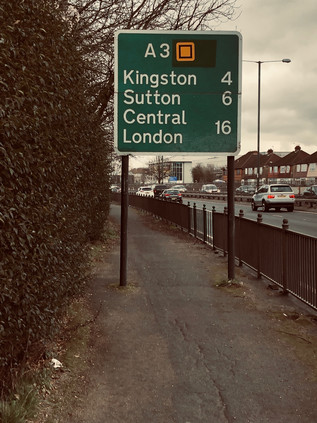I often write about being outside my comfort zone or having transgressed the boundaries which define my normal territory. In some ways, I've made a hobby out of challenging myself in terms of range and geography, however modestly. Today was different though - I really was in uncharted territory. This wasn't nearly as dangerous as it sounds - I was in Surrey. The south-western quadrant of London is largely a closed book to me, and I confess that in part this is due to a prejudice against the leafy comfort and perceived dullness of the stockbroker belt. I've occasionally transgressed: a conference at Kingston University saw me bunked in student accommodation at Seething Wells one overheated, sweaty summer weekend in 2004, and there was, of course, my excursion to J G Ballard's home just over the border in Shepperton. Otherwise, though, I've steered clear. I knew my wanderings would bring me here one day, just as the south-east was finally opened to me by way of rivers and roads which needed to be explored. But I'd left what I saw as the meagrest pickings until last, politely pushing them around the plate with my fork in the process. But now here I was disembarking at Thames Ditton - high above a flat, green landscape of privet hedges and driveways. The ageing electric train shuddered off towards its final call at Hampton Court as I descended to the road below. I was a fair distance from where I planned to start walking the A3, partly because the road executes a sweeping curve from the south to the east here. I'd contemplated starting at Chessington and heading west to the road, but it appeared to involve trudging a network of fast-trafficked, narrow rat-runs without pavements. Here however it was calm, quiet and eerily still. Perhaps a little too quiet? I imagined curtains twitching and neighbourhood watch call-lists being activated as I shambled scruffily along the street, stopping only to snap a picture of The Wrythe - a sorry little stream trapped between driveways and suspiciously full of builders rubble. Surrey had its secrets, it seems - but today I was heading for a comparatively prominent feature on the map. I skirted the apparently affluent and rather quaint village centre, turning south towards Giggs Hill Green and the apparently slightly less exclusive Hinchley Wood. A children's football tournament was underway, and I become swiftly embroiled in a crowd of fathers offering sage advice, a hand on the shoulder as they approached the pitch. On the other side of the street, an identical stream of men commiserated muddy charges back to their Range Rovers, banging the heavy clay from expensive boots on the fender. I crossed Portsmouth Road, the former route of the A3 before it was very comprehensively bypassed. It remained a busy road through the suburbs, and I pondered the choices I'd made here. Walking the modern route of the road felt right in terms of my project, but wrong in terms of this unexplored territory. I knew the environs of the A1 and A2 well enough, and I'd accidentally covered the ground their older routes traversed on other walks - but here I had little or no prior experience and I felt unprepared. The quiet backstreet I was wandering ended suddenly at a junction with the busy Kingston Bypass which merged with the A3 a little way ahead. But my decisions were made already, and I set off eastwards, towards the major road into London.
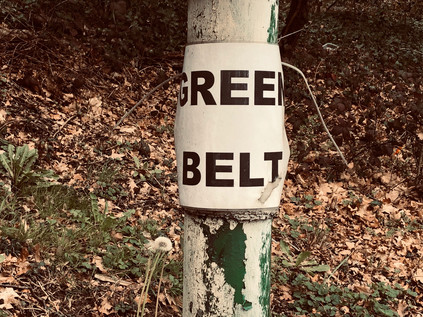
The Kingston Bypass met the A3 in a collision of old-school suburban bypass and modern, sweeping motorway-standard road. The arms of the older road splayed and opened to accommodate the new road, sweeping in from the south and turning sharply east. In the midst of this sprawled junction, broad grassy slopes sparkling with discarded plastic litter were crossed by a footpath - if I'd headed in from Chessington and braved the nervous pathless lanes, I'd have arrived here after a walk of a similar length. The slip roads blended into the main carriageway effortlessly, amongst a landscape of scrubby pasture, abandoned market gardens and occasional flapping roadside banners advertising equestrian businesses. This was the tattered edge of Surrey - the zone where the comfort and calm of the stockbroker belt merged into the enervated edges of London. It was here where commuting city workers would feel the pressure of their collars and the weight of their burdens as they motored gracefully around the curve and over the boundary. Of all the directions I've entered London, it was the most indistinct and the least prepossessing. As the arc of the A3 tapered into a long straight, dipping under the Hook Underpass ahead, my path took the northern flank of the remains of the old Kingston Bypass, a superseded road which ran alongside its modern counterpart but didn't fully connect. Just a short leap and a metal barrier away, traffic flashed by at high speed - but beside me all was quiet. I calculated I was closing on the spot where London began and looked for signs. There were several, but none were official: a fence ran along a ditch and the roadside vegetation was replaced by a familiar sort of 1970s noise-baffling concrete barrier which graced many urban roads into the city. At the very spot where I calculated that the line was crossed a dead fox was splayed on the verge, red-furred and graceful even after an apparently swift death. The road had claimed a sacrifice already today it seemed. Looking back over the eight lanes of tarmac, a sign facing west welcomed drivers to Surrey. There was no welcome on the road ahead.
The footway ascended to cross the A243, the underpass below narrowing and slowing as the more conservative speed limits of London brought thundering suburbanites to more reasonable speeds. This was reportedly the first such grade-separated underpass in the UK, originally opening with an innovative but incredibly noisy and inefficient heating system to prevent ice formation in the depths of the cutting which delved beneath the roundabout. My path skirted the sliproad onto the A3, passing a seemingly dull branch of Topps Tiles which had a more exciting heyday. This was the Ace of Spades: a huge roadhouse sited on the A3, marking the passage into or out of London. The venue featured an 800-seat restaurant which never closed, a swimming pool, a miniature golf course and offered cabaret until 3 am. Built in the 1930s, the building was popular with early stars of stage and screen and was by contemporary accounts, the place to be seen in these parts. However, the Ace of Spades fell on harder times in the 1950s and much of the complex was consumed by a huge fire in 1955. The last remaining parts of the building are above the ground floor here - a run of mock-Tudor gables which would have fronted the road but now provide space for bright advertising graphics, glowering across the cutting at the 'Ace Pharmacy' which has appropriated the lineage. It's hard to imagine such scenes here now, in a drab car park outside a tile store. These pockets of suburban history seem unlikely and are sometimes at risk of loss to grander projects. Across the street, the Cap In Hand had closed too, its modern conservatory boarded up, marking the closure of another generously overlarge 1930s hostelry. If Wetherspoons couldn't make a stab at running a pub here, there's probably no hope for such roadside taverns on the A3 now. No-one leaves the road this early, or indeed this late. Ruminating on the idea of the 'roadhouse' and how it had all but disappeared after a final - and remarkably, still lingering - fling with Little Chef in the 1980s, I struck out for the great, grey monolith of Tolworth Tower which dominated the view ahead. By far the tallest building for miles this grey slab dominated the skyline impressively with the road leading apparently directly to its feet. It was designed and built in the International Style by Seifert and Partners, and although criticised for being an inner city building located on the fringer, it was very deliberately conceived for this suburban spot, initially housing a range of government offices and private concerns. Parking around the tower would allow efficient commuting, drawing workers away from the precincts of the City which even as Tolworth was being finished in 1964, remained an ailing post-war patchwork of bombsites and construction projects. Initially, the ground floor was occupied by the long since disappeared supermarket Fine Fare which was reputedly the largest such store in Europe at the time. Now it's a still surprisingly large Marks & Spencer Food Hall, while the northern wing of the building above operates as a Travelodge hotel. I stepped briefly into the store for supplies, emerging to skirt around the elegant concrete legs on which the tower strides to face the road. The busy run of shops on Tolworth Broadway was attracting a fair Saturday morning crowd under the shade of this incongruous interloper.

The road began a slight descent, noticeable only due to the long view ahead into a hazy morning. A thinning out of the typical mid-century villas which lined my route indicated the crossing of the Hogsmill River. Rising in Ewell and flowing north to the Thames, this was a waterway I'd yet to walk. The opportunity had never quite been right - and of course, the prejudice against this corner of London remaining strong. A flurry of greenery flanked the river as it slunk along the bottom of a shallow valley in a concrete culvert, striking out for the medieval crossing at Kingston where I'd first seen it years ago beside the Coronation Stone. The paths beside the river were invitingly cool, offering relief from the dusty sidewalks which were unenviably close to the road - but this project was now advanced enough to seem important and I managed to resist deviation from the plan. The road pulsed: alternately flowing freely and congealing into a long rope of red brake lights stretching ahead into the suburbs. The traffic beside me started to jostle for the correct lane for the junction ahead, where multiple retail opportunities converged on the road. This was Shannon Corner - so named, like many of these out-of-the-city traffic pinch points, for a former factory and local employer: Shannon Systems, supplier of office equipment. The junction was once a tangle of traffic lights and trolley bus wires, with routes to New Malden and Worcester Park conveying suburbanites back and forth across the bypass. Now it was a soaring overpass, carrying traffic over the fringes of B&Q and Halfords towards a second chance to exit for the gargantuan Tesco Extra, just in case there was something you'd forgotten on the first pass. At ground level, it was a drab and rather testing part of the walk. The morning was warming up, and the fine dry weather was throwing up the surface grime of the road as I walked. Little thought had been given to the pedestrian here: everyone arrived and departed by car with the access prioritised accordingly. I navigated the entrances to the store car parks and crossed the arms of the huge roundabout near the former Duke of Cambridge pub - now the unlikely home of a Krispy Kreme franchise. The path climbed again, the jaws of the junction reclosing on the A3 as it turned north and swung slightly to the west, taking advantage of the easy contours of the valley formed by the Beverley Brook. The road also entered a rather greener section here: the flat, fertile valley bottom was home to a string of sports venues ranging from five-a-side football to 'Jurassic Golf'. I settled into the rhythm of the walk now, enjoying the chance to stretch my legs and beginning to make a compromise with myself: this felt like a really long route, and I might not finish this walk in one excursion. Perhaps breaking my own self-imposed rules would be no bad thing though? I'd rather doggedly pursued this series of walks - sometimes against my instincts - and some recalibration might mean I didn't feel quite so compelled by the conceit I'd devised around the 'ordinals'? The road crossed the mainline railway heading for Wimbledon and I stopped briefly to watch a train passing in the now rather fine, bright morning. I also began to feel that perhaps I'd been harsher on this area than I needed to be: no doubt it differed from my usual experiences of suburban walking, but here, crossing and recrossing Brook and its culverted tributaries as I progressed north, it was hard to feel anything but pleased to be out here and intrigued by the possibilities of new routes and unexplored valleys. I mentally mapped the winding watercourses, knowing I'd want to revisit at some point when freed from the obligation of walking into the City.
Soon, I was passing under the shadow of tall green roadsigns which signalled the end of the A3 as a proxy-motorway. The traffic streaming by began to concertina in a flurry of tail-lamps as the junction approached. A huge expanse of common land extended away to the east, but to the west, the road was hemmed in by the suburb of Kingston Vale. This uncelebrated and disconnected area of low-rise, mostly privately-built homes nestled into the elbow of the old and new roads slumbered in the late-rising luxury of a weekend morning, except for the two curved parades of shops which formed a ceremonial gateway to Grasmere Avenue where a cumbersome footbridge across the bypass touched down. The area was as much dependent on the road as it was blighted by its presence: everyone drove here, the nearest station awkwardly distant. Known for centuries as Kingston Bottom due to the slopes down to the marshy land and the Beverley Brook, development here gathered pace in the 20th century. The car made these disconnected little suburbs possible and still sustained them today. Somewhere beyond the estate, the old A3 plodded down Kingston Hill towards our confluence. Along the way it passed Holmwood the £11m gothic pile which once belonged to Rolling Stone Ronnie Wood until he decamped to Ireland with a Russian cocktail waitress, leaving his ex-wife to stage a series of revenge auctions culminating in the sale of the sprawling property with views over Richmond Park. The property, widely dubbed a 'party palace' finally sold for a full £2m under the asking price, I'm sure providing just a little satisfaction to the wronged, former Mrs Wood. A further, more noble and perhaps less contemporary artistic link to Kingston Vale lay in the clean, modern lines of Dorich House an unusual building which at first glance appears to have more in common with a mid-century factory or power station than a dwelling. In fact it combines art, industry and domicile: purpose-built by sculptor Dora Gordine in 1936, the lower floors provide lofty studios, plaster rooms and storage while a modest apartment above provided a home for her and husband Richard Hare, Earl of Listowel. Until his death in 1966 they were something of a powerhouse in the promotion of Slavonic arts and culture. Gordine, once mentioned as perhaps the finest woman sculptor of her time, began to fade from the public eye on Hare's death as tastes and fashions changed around her. In the following years, she continued to amass a collection of Russian art which is exhibited at the house today. Vacant since her death in 1991, the Grade II listed building is now in the care of Kingston University and also provides a centre for female practitioners of the arts. Set on the leafy ridge overlooking the green sweep of Richmond Park, it's perhaps not so difficult to see the attraction of Kingston Vale to artists of all kinds: not out-of-the-way but a little hard to reach. Not quite out of London, but almost in the leafy fringes of Surrey. The old road and the new finally collided at Robin Hood. Here at a remarkably poorly-planned convergence six lanes of high-speed traffic funnelled into four, with an additional local flow from Kingston piling back into the fray. The junction snarled-up and unjammed periodically, traffic pulsing rather than flowing through the complex. The origins of the name Robin Hood here are vague but like all the best tales they have been absorbed into the local fabric, providing a geographical context for dry cleaners, off licenses and car dealerships alongside the lanes and walks which have existed since Tudor times on the park's edge. It is thought that Henry VIII's fascination with the myth of Robin Hood led to the inclusion of an outlaw character in the May Games which amused court on the ancient lands of Richmond Park each year, and certainly, the name is recorded locally in the 16th century as 'Robynhood Walke'. Later, the southeastern gate of the park which I was about to pass at the end of a grubby little terrace also adopted the name, as did a local ecclesiastical parish. Names have a habit of sticking fast on the edges of London, and while the north and east have Dick Turpin as their genus loci, the south shares its unlikely hero with Sherwood Forest. Sometimes, the reverse mythology completes the circle too, with the chaotic roar of the near-present immortalised in the picturesque. As I prepared to negotiate the tangle of pedestrian crossings at Robin Hood, I noted a pair of semi-detached homes behind tall hedges and tidy gardens with a small nameplate high on the wall which honoured the mighty A3 in their name: By-pass Cottages.
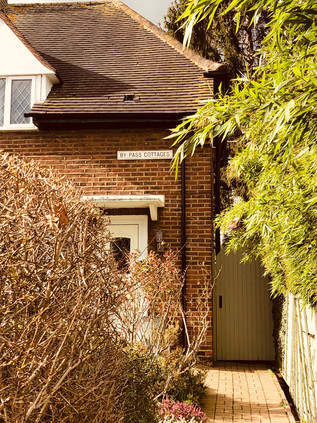
The Robin Hood Gate was set back from the road, a hint of the greenery inside the park just visible from the grey dust of the footpath, just a little way from my final crossing of the Beverley Brook. The bridge parapets would be barely visible to passing drivers, but on close examination they bore a record of an old boundary etched into their pollution-scoured stonework - to the west, Surrey County Council and to the east the former London County Council. The long slow drag up to Roehampton was still an administrative nexus, where the road marked a point where the Boroughs of Merton, Kingston and Richmond encircled a narrow outflung arm of Wandsworth just wide enough to accommodate the hill I was about to climb and the Richardson Evans Memorial Sports Grounds. It seemed fitting that Richardson Evans, colonial bureaucrat turned defender of rural beauty, should be commemorated here on the edge of the deer park - but it was also perhaps a little ironic given the total encircling of London, jeopardising many of the scenic vistas he sought to protect. A founder of the Society for Checking the Abuses in Public Advertising (or the catchier SCAPA) he supported legislation to prevent advertising in fields along the railway. In an article in the National Review in 1890 entitled 'The Age of Disfigurement' he strengthened his resolve, advocating boycott of the goods of offending advertisers and taxation of profits from such advertisements. He is celebrated at Owler Tor in the Peak District too where he did much to protect views across what later became Britain's first national park, his widow gifting a substantial tract of land in his name. The views across Richmond had changed from Evans' time for sure - not least in the form of the Alton Estate, a range of elegant tower blocks which snaked across the edge of the rising land between the Beverley Brook and the Wandle valley. Set perfectly on the falling slope of the tree-covered bluff as it turned west to break on the shores of Richmond Park, the developments were spaced thoughtfully, allowing glimpses between the buildings and to the distant Thames and City. The Alton Estate was designed by a team at the London County Council led by Rosemary Stjernstedt, and remains one of the largest developments of public housing in Europe today. Arguably, it is also one of the more architecturally and socially successful examples, and despite the usual issues of antisocial behaviour which stem more from modern estate management than design, it remains a much-loved placed to live. Divided into two distinct sections, Alton East lay before me - a range of point blocks with snakes of low-rise homes between them which peppered the wooded ridge of Roehampton. The buildings appeared to form part of their environment, there was something organic about their slender. sprouting forms. In the hazy distance, the five slab blocks of Alton West stacked towards the horizon. Largely replacing Georgian villas and their grounds, these elegant blocks are raised above the ground in the manner of Le Corbusier's machine-Ã -habiter masterplan for such developments. Elsewhere in Britain - for example at Broadwater Farm - this practice has left a dark, forbidding chasm below the blocks, ripe for exploitation by those who desire secrecy and seclusion. But here it responds to the site: the glimpses of greenery and sky tie the buildings to the ground and it remains evident why the original inhabitants of Roehampton chose to populate this ridge centuries ago. Stjernstedt and her team realised that despite all their training in the proper ways of architecture, they needed to listen to the landscape and its former stewards. When the LCC dissolved in 1965 she moved to the new borough of Lambeth working with Ted Hollamby and oversaw the equally successful Central Hill estate. There is a hackneyed and perhaps over-worked point to consider that while the great architects of brutalism who imposed their experiments on the world were largely men, it was a woman who fully realised and humanised the style in a manner which garnered popularity with those who lived within. Ted Hollamby, would touch the route of the A3 again later in the journey and a little further into the great modernist experiments in housing. While from my vantage point beside the road I could appreciate the sweep and ambition of Alton, the detail of its blend of modernism, formalism and brutalism was lost to the horizon. So it became somewhere to revisit soon, I decided. I pressed onward, the climb waking up tired legs. The walk felt vital and possible again and I strode ahead optimistically until I saw the sign...
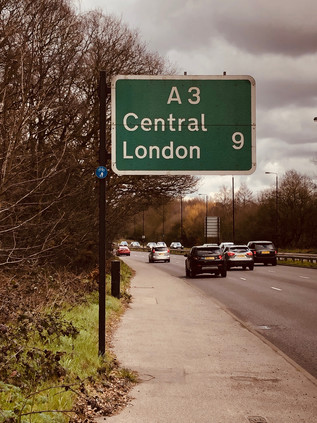
For a moment, it seemed impossible, and perhaps even futile... Who was I kidding? This was futile, but it was my quest and only I could curtail it. I couldn't brook the imposition of failure from outside, even in truth I'd perhaps overestimated my range here. I felt like I'd been walking for miles, but the indirect geography of the A3 meant I was still miles from my goal. In its modern form this is a polite road, twisted around communities and tunnelling under areas of scientific interest and beauty. The old road was more direct, unquestioningly serving the need to link the Naval stronghold at Portsmouth with London since Tudor times. Now that I was back on the former route, things would perhaps feel more direct? Lost in contemplation of the long walk still ahead, I began the descent into the Wandle Valley and soon encountered familiar terrain as the South Circular joined my route. I recalled feeling cowed by distance on that walk too and took some comfort from knowing that I'd managed that trek well enough. As I descended into Wandsworth, the sun broke through once again and the view over the valley opened before me. I felt somewhat restored, and able to push on despite my misgivings. My descent of West Hill led me by the Royal Hospital for Neuro-disability, an internationally renowned centre for the treatment of acquired brain injury. Occupying Melrose Hall, a former private dwelling, since 1863 the facility was established under the blunt and un-euphemistic Victorian name of the 'Hospital for Incurables', and has received patronage from Dickens, Betjeman and Hardy among the usual cast of royals and philanthropists. The impressive facade of the original house glowed in the sunshine, with its sympathetically added, rather grand projecting wings standing proudly against the sluggish stop-start traffic which irritably progressed towards the centre of Wandsworth, no choice but to convene on this single, old road into town. I savoured the descent as a pedestrian: slowly emerging into the busy town centre, now mercifully emerging from months of building works which had choked the streets and masked the river from view. Now, at last, the new waterside housing blocks were complete and the view towards the Thames was once again opened up. Granted it was much sanitised, with new planting and pedestrian priority the main improvements, but it was odd not to see the sluggish brown waters lapping against the muddy banks under the shadow of the working brewery. This development had not been without challenges to retain the character of former site, but the new buildings were anodyne and artless while of course wonderfully situated, enclosing private gardens and riverside terraces. Also inevitably the new area was a 'quarter' - the perennial Estate Agent's vernacular for such reclaimed sites. The Ram Brewery's main buildings still stood - now home to '14 unique apartments' - but the distinctive warm air and tang of fermentation on the breeze was gone. Wandsworth however, appeared to go from strength to strength, the shopping centre teeming with life and the seemingly ever-present street food market wafting new aromas across the river. I lingered long enough to spy a couple from one of the blocks staring silently into the Wandle, almost trying to puzzle out why their expensive apartment had been anchored next to these ancient, muddy banks? It was time to climb out of the valley and head for town, once again passing the impressive civic buildings which housed the Borough Council, and the near-forgotten Huguenot Burial Ground at Mount Nod.
Much of my route for the next leg of the journey was familiar from walking around the South Circular. The A3 and the A205 are uncomfortable partners here, both busy routes squeezed into a gyratory which wheels around Clapham Common, spinning traffic off towards the south-western suburbs. The Common basked in the afternoon sun, the locals coaxed out to lounge or walk - one of the few things to do here which didn't seem to cost money. I noticed a trend I'd spotted countless times around the fringe of the city: young couples walking in a simulacrum of the historic promenade. Being seen out in the public green-spaces of London is an often classless but rarely costless activity, and there was evidence that a great deal had been spent on wearing just the right gear: North Face jackets zipped to the neck with a scarf against the still-biting March breezes, aviator sunglasses mirroring the traffic-lights back at passers-by. I outpaced these couples as they sauntered, largely indifferent to other passers-by and with what little I gleaned of their private conversations they appeared more focused on minor friendship squabbles, petty work dilemmas or social media indiscretions. These couples appeared to be in arrested adolescence: functioning members of society engaged in presumably valuable employment, but trapped on the very edge of adulthood, perpetually waiting for the right time to take the leap. In fairness, the rest of us were hardly helping them, and a little flurry of discarded UKIP leaflets flapping around the pavement in the breeze full of ill-informed bile reminded me that the current climate would make anyone think twice about being part of this mess. The Common remained timeless though - surrounded by grand houses which had housed generations of comfortable but radical types and flanked by streets full of fashionable eating and drinking places. Wandsworth evaporated into Lambeth, and I had a brief but misleading sense that I was nearing my goal. There was a distinct shift into Inner London here, and the squashed cathedral-like dome of Clapham Common Underground Station kicked off a long, busy High Street of nudging buses and slow traffic which seemed remote from the high-speed clamour of the A3 out in Surrey.
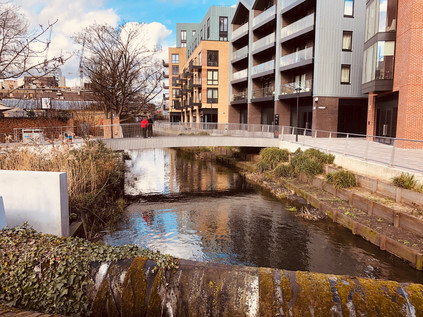
With the shift to inner London came a greater number of people to slalom around. While Wandsworth had prepared me somewhat for the volume of humanity, and the steady flow of pedestrians along the Common had indicated the ambling pace most of the people I now encountered would match, I hadn't been ready for the combination: a slow-moving crowd of people picking over the offer of the long strand of restaurants and bars. Clapham had varied in its fortunes over the years, moving from exclusive rural retreat to fashionable suburb, then for a while regressing into shabby, distressed city-fringe bedsit land. In the meantime it had become the byword for all that was unsurprising and reasonable - the commuter on the eponymous 'Clapham omnibus' riding the network in smug certainty of his eminent sensibleness. But now Clapham was shifting up again, and it was clear where the slow-moving promenaders I'd overtaken were heading. Being seen hereabouts was as important as being here, and wherever there was an opportunity to sit outdoors on the pavement, those who could afford it had taken it up while those who couldn't slunk by absorbing the vape clouds and reflected glory. The oldest suburban traditions held fast: if you couldn't be with the right people, be near them:
The great number of insignificant People who are by no means fit for the better sort of Conversation, and yet have an impertinent Ambition of appearing with those to whom they are not welcome.'The Spectator, No. 24 - March 1711
The bustling string of upscale establishments had a good run, but it came decisively to an end at the railway overbridge near Clapham High Street station. Overground trains rattled by reassuringly often and there was considerable foot traffic between the station and the nearby tube entrance, but otherwise, my surroundings became suddenly drab and downbeat. Almost reassuringly so, and I confess to feeling instantly better fitted to circumstances. I'd shambled in from the edge of the city, walking for sweaty and dusty miles and getting progressively less suitable for the kind of company I'd kept for the last mile or so. I was aware that I was frowning and perhaps even muttering irritably to myself as I jostled for space on the pavement among the purposeless amblers out for a stroll. I had no more right to occupy a contested sliver of sidewalk of course, possibly in many ways even less - but I'd convinced myself of a purpose and I wasn't going to be thwarted.
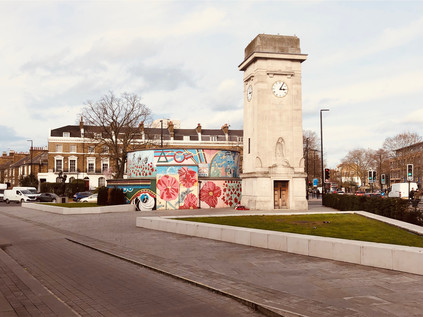
The road straightened and headed unrelentingly towards the city marking a transition into Stockwell which was gentle and surprisingly leafy. The street was lined with the kind of mid-century tenement blocks which had sprung up to resolve the first great housing crisis south of the river as slums were cleared and development edged west along the Thames. These blocks were interspersed with the kind of low-rise estate-as-community projects beloved of the Borough until they were pushed into more drastic action in the late 1950s. Tall buildings along this stretch of the A3 were relatively rare, and where they did rise over the rather traditional street frontage they were solid little point blocks, resolute and robust. The area had a sense of calm, commonplace continuity. There was a sense that important things happened elsewhere. But the cluster of statues and memorials which were grouped around the Underground Station told another story of Stockwell: one which mixed the everyday acts of wartime bravery celebrated on village greens across the country with surprising acts of uncommon heroism. The formal War Memorial is a stocky and austere stone cenotaph, sparsely embossed with delicate carvings and housing a four-faced clock. Beside it, the brick drums of the surface entrance to the deep-level tube tunnels beneath the Northern Line which served as air-raid shelters were decorated with a colourful mural depicting people and events from the history of the area. Local boy turned actor Roger Moore appeared as James Bond beside a scene depicting the arrival of the Empire Windrush which greatly diversified the life of the Borough. Beside them glowered Vincent Van Gogh who lived nearby in Hackford Road while working as a London agent for art dealers Goupil & Cie. Alongside these better-known local luminaries, however, was recorded the little-known story of Violette Szabo. Raised in France to British and French parents, Szabo returned to South London aged 11 and despite a reportedly 'boyish' athletic streak and quick wit, settled into what was typical work for women of the day in the Oxford Street branch of Woolworths, and the Le Bon Marché department store in Brixton. As part of the early war effort, she worked variously in the Women's Land Army and in munitions factories, meeting her Franco-Hungarian husband Etienne Szabo on Bastille Day in 1940. They were swiftly married as was the wartime custom, and he returned to service in the French Foreign Legion in North Africa. Around this time, Violette was recruited through unknown routes, to the Special Operations Executive, finally completing her training in January 1944. She was to make two missions into occupied France working to support Resistance networks and to disrupt Nazi efforts to quell the Normandy landings. During her second mission, she was captured, turned over to the SS and after an arduous journey east, set to hard labour in Ravensbrück Concentration Camp. Her record of dissent and non-compliance in the camp alongside her continued efforts to buoy the spirits of other prisoners and outspoken commitment to finding a means of escape finally brought a response from the highest authorities of the Third Reich which regarded resistance fighters and undercover operatives as outside the Geneva Convention. Thus, orders were given for Szabo's execution during early February 1945 and aged 23, the woman referred to by Leo Marks as 'A dark-haired slip of mischief' was shot dead. So much of her story as reported emphasises how untypical her qualities were for women of the time - but perhaps the only truly untypical thing about Szabo was her incredible behaviour.
But not all of the memorials clustered around this tiny remaining scrap of Stockwell Common harked back to the impossible horrors of war in foreign lands: some were nearer to home and chillingly closer to now. On 22nd July 2005, Brazillian electrician Jean Charles de Menezes was shot and killed at close range by undercover Metropolitan Police officers - possibly accompanied by members of the Special Forces - pursuing him in the mistaken belief that he was one of the suspects responsible for the bombings in London on 7th July. The confusion, disinformation and collusion to hide the facts of a botched operation which followed the shooting represent some of the darkest days of the Metropolitan Police, and showed an organisation in chaos following the catastrophic assault on the capital and buckling under the strain of the vast operation to track down the perpetrators who were still at large. It also exposed the shocking susceptibility of the modern news media to rumour, supposition and opinion as the chasm-like lack of an official response was filled with variant eye-witness reports, amateur detective work and plain old guesswork. While there was a strong post-incident belief that de Menezes was being smeared in an attempt to justify the extreme force used, it's far more likely that the then largely unchallenged powers of the media were simply extrapolating any rumour into an already complex web of fact, fiction and half-understood intelligence gleaned from sources of varying credibility. Today, the shrine which swiftly grew next to the news kiosk outside the station has taken a more permanent form as a mosaic designed by local artist Mary Edwards in collaboration with Jean Charles' cousin Vivian Figueiredo, and Chrysoula Vardax who had cared for the original shrine. The mural watches over the passing pedestrians on the street, walking safely in the belief that they are protected from the actions of hidden terrorists but reminding us that the very structures that protect us can turn on the innocent in times of horror and doubt. Stockwell feels inconsequential on the surface - another bit of London most of us would be hard pressed to identify, and with no clearly defined beginning or ending - but like almost every suburb it has a narrative buried in the dust of its pavements.
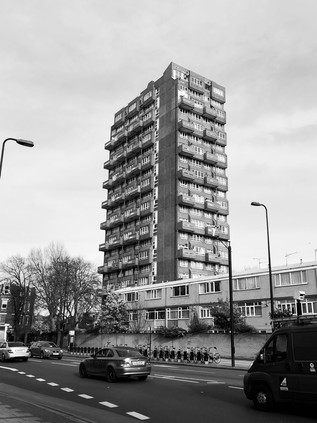
After the surprisingly arresting crossing of Stockwell I entered a zone far more identifiable as London. The road here surfed the boundary of Lambeth and Southwark, and marked a more significant architectural divide: low brick blocks in the London County Council tradition flanking the grand sweep of Surrey Cricket Club's ground at The Oval to the north, while high-rise towers of concrete loomed from the south. South London expanded quickly in the 19th century, building on an already established and busy street pattern of poor quality homes nearer the river, where burgeoning industries needed a supply of workers. The clearance of slums wasn't swift, and despite efforts to improve conditions between the wars, the drive to provide a sufficient quantity and quality of housing only really found its feet after 1945 when many thousands of homes were already lost. This meant that the need was urgent: a dizzying array of system-built schemes, experimental designs and one-off projects began to crop-up in the southern boroughs. Young, modern-minded architects who would struggle to find commissions in the fairly stuffy pre-war boroughs were now pressed into urgent service, their most unusual ideas fine provided the numbers stacked up. In Lambeth and Southwark this resulted in clusters of redevelopment around the areas worst affected by bombing or where slum clearance left the most gaping holes in the infrastructure. It also made for accidental grace in utility, with the sweeping concrete spans of Stockwell Bus Garage just a brief detour away from the road. The A3 now ebbed and flowed from traffic-light to traffic-light, slowly pushing traffic further into the heart of London. Alongside the road, with their roots buried in the backstreets sprouted a crop of towers apparently built from a crazy tumble of balconies stacked atop each other. In fact, balconies seemed quite the thing here. Not for Southwark were the sleek, clean lines of Le Corbusier or the cliff-like slabs which were being cranked out through Laing's Jespersen System. Ted Hollamby's Pinter, Arden and Beckett Houses protruded like off-white fangs, their irregular sided profiles casting uncanny shadows over the neighbourhood. Meanwhile, another Hollamby-led high-rise scheme at Holland Rise House included the same curious buckled fascia with waves of concrete balconies cascading down the tall tower, but in the original pebbledashed raw concrete and with a weathered exterior looked a rather grimmer proposition. Ted Hollamby led the charge towards high-rise living in Lambeth, overseeing its transition following the reorganisation of London government in 1965 and continuing to build in the unusual style seen here. Hollamby continued to work in Lambeth until 1980s when the Labour-led Borough's policies finally drove him into the private sector, largely against his socialist principles. There he worked to secure the redevelopment of the Isle of Dogs and campaigned for the building of the Docklands Light Railway. Hollamby left the role of Chief Planner and Architect of the LDDC in 1985, concerned about the direction of the second phase and particularly the Canary Wharf project. He died in 1999 at William Morris' Red House in Bexleyheath, a property he and his wife had assisted in saving from decay decades earlier. Looking ahead, the shining, modern towers of a future city at Elephant and Castle were beginning to in the shimmering sunshine of the advancing afternoon, and given his later work for the market it would have been interesting to know Ted Hollamby's thoughts on modern London and its precarious housing situation?

Most often referred to simply as 'The Elephant' this place, while feeling decidedly modern, has a rather more distant origin. There was an already long-established crossing of ways here by 1641 when John Flaxman built a forge to serve passing traffic. A tavern followed, and its location at the nexus of routes between Kent, the South Coast and London made it a popular place to pause but eventually a fashionable outpost in its own right. By the turn of the 20th century, both the railway and the Underground had echoed this ancient pattern and built a place of interchange at Elephant and Castle. Unlike the busy circuses of the North, this South London hub was a little more lawless and ungoverned continuing the long South Bank tradition which had seen it noted for bawdy theatres, licentiousness and bear-baiting. When the motorcar arrived, the Elephant became a whirling, impossible-to-fathom circus of routes. Local traffic vyed with long-distance routes, and the pedestrian was relegated to a supporting role in the drama of the junction. Then the war came, and it landed hard on this important spot. The historic fabric of the area was almost entirely destroyed in the Blitz leaving great need of housing, but in the eyes of reform-minded borough planners, a great opportunity too. The re-development of Elephant and Castle is not an entirely happy story, but it has achieved one of the goals of the planners: it has maintained a sense of local community. It largely did this by creating vast estates, snaking away into the suburbs which were capable of housing almost all of those displaced by the bombing. The huge concrete wall of the now demolished Heygate Estate, penetrated only via the circuitous ramps and walkways which created a haven for those who wanted to lose or become lost may have presented huge social challenges to the authorities, but it also meant that families who identified as South East Londoners remained in the city and weren't decanted to the fringes. Around the junction though, this made for a strange hotch-potch of schemes washing up against the tide of traffic, dominated by the currently part-demolished anachronism of the Shopping Centre. A modern precinct buried under residential towers, this local commercial hub had managed to remain a part of the fabric of the area despite never really attracting big name stores. Now it was part-deleted, the plastic cladding which had artificially aged the structure gone, but the period lettering proclaiming its purpose still intact above the ill-fitting pagoda entrance. Inside, I could imagine the smell of disinfectant and the creak of a fixed plastic chair in the Wimpy Bar. Around the stricken and soon to be revitalised shopping centre the ages of Elephant unravelled: the shining oxblood tiles of Leslie Green's 1906 Bakerloo Line station faced-off against the difficult-to-like fang of Strata SE1 finished in 2010, with its tapered roofline supporting three apparently non-functional wind turbines. The classical columns of the Metropolitan Tabernacle meanwhile, were offset by Metro Central Heights - formerly the Department of Health offices, when built known as Alexander Fleming House. This clean, functional set of blocks was an early London commission for Ernö Goldfinger, setting out his stall and predicting his future clustering of high- and low-rise blocks, but succumbing to a reputation for 'sick building syndrome' which saw the Civil Servants move on and eventually, a award-winning future as a residential block. Finally, the off-kilter slab of Perronet House occupied a windswept corner: designed by Sir Roger Walters to offer split level 'scissor flats' with views from both levels, this block was the focus of a movement of guerilla gardeners during the late 2000s. Centring on activist Richard Reynolds, their activities in beautifying the Elephant long predate current schemes to improve the area. And what of those schemes? The swirling roundabout of traffic has been 'peninsularised' into a freer-flowing inverted question-mark, with the A3 weaving through it and not-quite-circling the electricity substation which doubles as a monument to Michael Faraday, born nearby on Newington Butts. As I tracked the road around, grabbing my hat to stop it being swept away by the wind gusting across the expanse of featureless but tidy new public realm, I thought about my first visit to this area when attending a training course for work in around 2005. Descending from the grimly dilapidated station and hurrying by the overbearing slabs of the Heygate Estate, we scuttled into a spartan and rather eerie budget hotel for the night, emerging only to eat an overpriced Indian meal before bunkering down for an hour or so in The Rockingham Arms - a frankly terrifying local Wetherspoons pub. I hadn't realised back then that this grim bolthole, selected to delay my return to an equally unedifying hotel, was a little corner of a Goldfinger development nor that it was named for a geological feature which would come to intrigue me years later. In the bright sunshine of the afternoon which bounced off the metal and glass of new towers of unaffordable housing, it didn't seem quite as forbidding perhaps? Whether the Elephant would retain its character and identity or whether the rather curious malaise which seemed to scupper every change would prevail, remained to be seen.
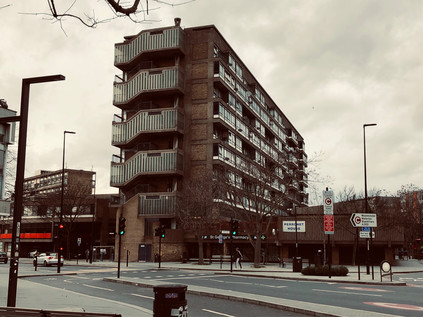
Unreal City,
Under the brown fog of a winter dawn,
A crowd flowed over London Bridge, so many
I had not thought death had undone so many.
Sighs, short and infrequent, were exhaled,
And each man fixed his eyes before his feet.
T.S. Eliot - The Waste Land, 1922
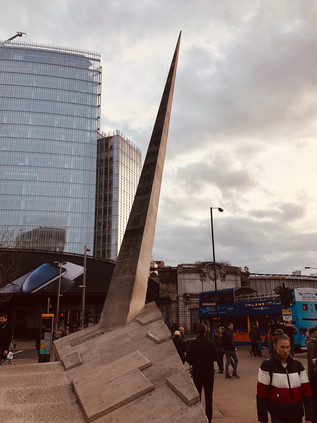
Still with Eliot in mind when I touched down in the City of London at last, I turned west and headed along King William Street towards St. Mary Woolnoth. This strange, unchristian edifice had long fascinated me and had drawn me east when I still felt that this zone was beyond the pale. Much of my long walk into London along the A3 had been in areas I'd felt were similarly alien at one time: the ungoverned precincts of grubby, ancient Southwark fell first - the past just too alluring to avoid them. Then the eternally morose, forever embattled zone of Elephant and Castle with its roots in deepest prehistory. Finally, the suburban banality of edgeland Surrey - quiet and unremarkable on the surface, but with unexpected stories hidden behind its net curtains. The A3 had promised little beyond a good long walk, but it had delivered far more than I expected. Of all the roads I'd walk as part of this exercise, it was the one I'd encountered least, but may be the one I'd remember longest. As I finally took the pressure of my aching soles in a long-familiar coffee shop I'd already begun to delve into the stories twined inextricably around the oddities I'd discovered. The A3 was unexpected - a route of anomalies - architectural, geological and societal.
You can find more pictures from the walk here.
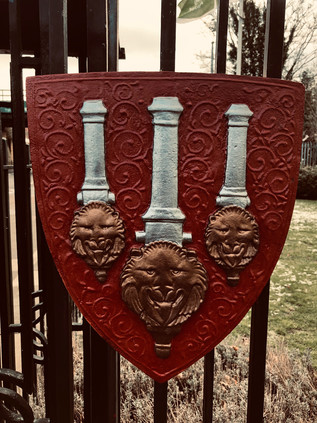
London Ordinal: The A2 - A Spark In Your Veins
Posted in London on Saturday 2nd February 2019 at 11:02pm
I'll start at the end... I'm in the same coffee shop which I headed for at the end of my last walk. An old haunt, a staging post on the way back west after conferences in Bloomsbury or casing the City, worrying about appearing on too many CCTV feeds. I've gravitated here repeatedly over the years because there is something comforting about being above the outflow of the River Fleet, at the end of a mysterious valley which was part of the reason I began to walk around London. It's quiet here again, I sip coffee and write, my feet buzzing with the heat of a walk completed, my calf muscles occasionally tightening unexpectedly as they relax from their exertions. When I set out on this new project, inspired by a return to the road which was in some ways unexpected, it had seemed like a simple enough proposition to walk into London from five different directions, governed only by the vagaries of the 1922 road numbering system. The spider of primary routes out of the city was strange and compelling to me - the roads struck definite, carefully defined courses from the suburbs, but blundered to indistinct ends in the centre of things. Road numbers weren't important in the heart of the old City. Destinations were close at hand: Holborn, Shoreditch, Angel. London looked inwards. It was miles out of town before the A1 gave up its first sign to 'The NORTH'. I'd also surprised myself by obeying the correct order: today I'd headed out to the edge of Kent to walk the A2 from the boundary to the centre. I realised that this locked me into an expectation of compliance with my own rules, and I somehow knew I was likely to follow the preordained pattern: walking might be an act of revolution, but I was no revolutionary. The familiar trip out over the rooftops of London Bridge towards the suburbs was relaxing and almost beautiful with the remainder of snowfall from last week lingering in sheltered spots. I'd dressed for the weather I didn't want to find, but hoped for the bright, cold day predicted. Crossing the Thames in a light flurry of powdery snow didn't bode well, however. I tightened my scarf for the walk ahead.
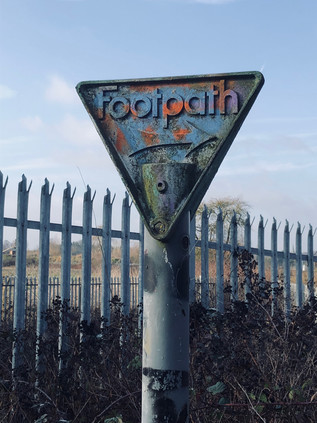
I stepped off the train onto a slushy, slippery platform at Crayford. The landscape felt familiar but was changed by the perils of the icy pavement, keeping my focus just one step ahead of my feet. I headed over the treacherous footbridge and into the backroads which led south along the railway line. I was looking for the entrance to Braeburn Park and Nature Reserve, an extensive but pleasingly unkempt angle of wilderness between the railway line and the A2 as it meandered in from Kent. I hadn't quite crossed the county boundary today: that lay further back towards Dartford, but I was as close as I could easily get as the A2 between here and Dartford was not for pedestrians. I met it instead at a low bridge over the rails, a tiny and rather forbidding path carved into the embankment and indicated by a heavily redecorated 'Footpath' sign. The area had been sequestered for drainage works, with huge tracts freshly of remediated topsoil strewn across a wide triangle of churned land. Everything screamed 'no entry' and I felt a mixture of mischief and surprise when I strode out rather confidently across the patch to find the path which hugged the railway under the bridge and then climbed to join the angry rush of traffic on the dual carriageway. This was the last chance of escape - from the road, and from my rules. Another path led away south, towards Old Bexley and the valley of the River Cray. But again I stuck to the plan and at the head of the slope found myself edging along a narrow path between the hard shoulder and the parapet of the bridge. It seemed likely that the path alongside the eastbound carriageway was better favoured, but I wanted to walk on this side, at least at first. The path soon parted from the road under a sign telling the most polluting vehicles to leave at the next exit to avoid the Low Emission Zone. Delving steeply down again into a snowy gully, I began to enjoy the challenge of the walk. The sky was brightening and any threat of new snow seemed to be passing. I was alone on the remote path despite being mere inches from thousands of motorists. I felt in my element again. Trudging slushily through the snow, I soon came upon the reason for staying on this side of the road: beneath me, the silvery waters of the River Cray were joined by the smaller River Shuttle at a busy, angular confluence. Both rivers were swollen by melting snow and ice, and their junction glistened through the tangle of wintry branches below. Like all confluences, this felt like a significant moment. It had been hard to walk near the Cray on this part of its journey, and these last metres of the Shuttle were almost entirely inaccessible. Passing over the Cray here linked me to previous endeavours and added another junction to my mental map of these south-eastern reaches of London which had been a relative mystery until recent years. I moved on, crossing the complicated loops of the Black Prince junction, the Shuttle now in an anonymous concrete culvert beside me and relegated to the role of a drainage ditch for the hotel site. The Black Prince was now a chain hotel, its mock Tudor facade fronting a quadrangle of more recent and less showy low brick blocks, ideally situated for the commercial traveller breaking a journey on the road to Kent, though it was unclear how many did so nowadays. Named for a supposed haunting of nearby Hall Place by Edward of Woodstock who rested there on route to war in France, it was also a staging-post in the career of another Edward: the late Prime Minister Heath who bunked here during his campaign to be elected MP for Bexley in 1950. The slip-roads swirled around the faded hotel as I returned to the road with the River Shuttle beside me, for a little while at least. The alignment of the route used the floor of the valley created by this tiny river to give it a flat and broadly straight route west. I stayed close to the rush of traffic, my route varying from slippery, frost covered footpath to a secondary service road serving the decent, large villas which lined the A2. The sun was climbing over my shoulder and the day was shaping up to be remarkably bright given the conditions I'd prepared for. I struck out at a surprisingly brisk clip, enjoying the walk.
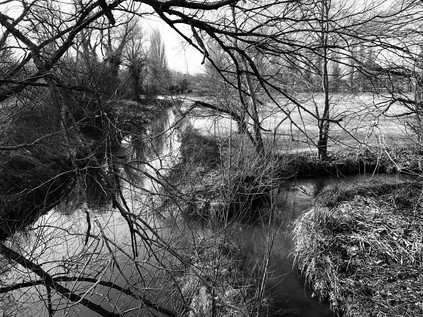
The A2 is a bypass of an ancient route through Kent, which since the 1930s has taken a far more meandering route than the direct, Roman road which ran a little way to the north. The advantage of this southern course was avoiding the steep ascent of Shooters Hill and the passage through the challenging darkness of the woods which blanketed the climb. Between these old and new strategic routes was the broad commuter-belt swathe of Bexleyheath, with its shopping centres and carparks which I'd picked my way across when negotiating Watling Street. I crossed the current route at a footbridge, going against my usual practice: I usually walked with the traffic, preferring the gentle swish of cars passing rather than the unsettling flood of headlights apparently careering towards me. I'd fathomed from very cursory checks that the route might just be easier at the Danson Interchange if I was on this side of the street. In practice, there appeared to be very little to choose with both footpaths requiring a scurry down to the A211 via a staircase, before ascending and reappearing in a narrow alley running across the front of homes otherwise marooned by the highway, widened considerably since building at the cost of their front gardens. The sheltered footpath was still strewn with snow which the sun hadn't yet reached which concealed a carpet of frozen litter tossed from passing cars, and I picked my way along carefully meeting only a postman and an agitated man twitching his way home urgently accompanied by the telltale clinking of a blue carrier bag. I passed the grey reverse sides of huge roadsigns which dwarfed the suburban street furniture around them, casting long shadows in the wintry sunlight and filling the views from the homes along the route. I'd found my stride and I was walking at a fair pace now - but London still felt improbably distant, the long tarmac strap of the A2 slowly unwinding towards the remote city ahead. I surely couldn't reach the centre of things in one walk, could I? Thankfully at least, the house numbers were increasing: there is perhaps nothing so disturbing as realising that the properties alongside a long route are slowly counting down from some currently impossible total, the walk becoming an endurance test. The road continued in its deep trough between the rising woodland of Danson Park and the suburban hinterlands to the south. This clearly wasn't going to make a great story: it was just an arterial route into London, seemingly unremarkable in every sense. There appeared to be few secrets to uncover as the road ploughed onward, arrow-straight and apparently endless, passing the mysteriously named village of Blackfen and pressing on towards Falconwood. The names of these settlements along the route hinted at a less prosaic past buried under the asphalt skin of the road: a history of settlement reaching back into the Bronze Age. At Falconwood my route accidentally diverged from the current A2, threatening instead to follow the line of the 1930s bypass towards the foot of Shooters Hill. I was momentarily wrong-footed by this little nexus of bridges crossing roads and railways, confused by the need to navigate back to the road having barely realised my path was parting from it. A footway through the northern section of Eltham Park led away from the station, but staying true to my purpose I turned to cross the bridge again, passing over the tide of traffic and slithering on the icy pavement which hadn't yet seen sufficient foot traffic to see off the slippery covering of the last few days. As I trudged along a high, narrow causeway above the road I gazed rather enviously across at the tangled trees of Eltham Park North, climbing towards Shepherdleas Wood, and beyond to the peak of Oxleas Wood. A road not unlike this could have put paid to the whole sweep of green I was surveying - indeed there has been an almost indecent interest in ploughing across this ancient woodland and high ground at various points: Ringway 2 would have swept in a little way to the west, while the approach roads for an unbuilt East London Crossing linking Beckton with Thamesmead would have taken an even more direct route through the spot where I was standing. It was hard to understand why this area was so prone to these schemes: the terrain here is far from easy, the rising and falling land between the A2 and the Thames presents challenges of both terrain and contour. Perhaps it stemmed from an unconscious need to tame Shooter's Hill? The old haunt of pagan Britons, murderous thieves, Droogs? The road into the City shone in a surprising burst of sunshine while the dull grey trees, shorn of foliage glowered back at me from the woods to the north. As I surveyed the frosted green carpet of Eltham Park South with distant houses rising from the misty edges of the field, it was easy to be persuaded I'd taken the right path...
Just as the day began to wane and darken, O'er the high hill, which looks with pride or scorn Toward the great city. - Ye who have a spark in Your veins of Cockney spirit, smile or mourn According as you take things well or ill; - Bold Britons, we are now on Shooter's Hill!Lord Byron - Don Juan, 1818-24
Now curving to the north-west, the new course of the A2 continued. Opened in 1985, the Rochester Way Relief Road was a bypass for the original bypass. A desperate attempt to keep the traffic flowing around the congested ventricles of south-east London. Now mired in suburban sprawl the once broad and open arterial route was hemmed in by development and plagued by snarls around junctions with side-roads. Providing a good, straight road into the city which bypassed the slog up the hill had been counterproductive, producing new and heavier flows of traffic along the road in from Kent. The new road provided opportunities for rail too, consolidating the former Eltham Park and Eltham Well Hall stations into a single, modern facility on a raft above the new road. The two stations had been close together - within a few hundred yards of each other - both located on side-streets which weren't close to the local amenities of Well Hall Road. As I skirted the chasm containing both road and railway in a narrow but pleasant strip of landscaped greenery, I passed the site of the former Well Hall station, a fine old building on Westmount Road which had seen better days, but showed signs of regeneration as a pottery shop had opened in one of its flanks. The remaining parts were 'to let', the 'Station Parade' lettering rusting on the gable. It had still fared better than Eltham Park station which had been entirely swept away by the new road. The replacement station was approached by a broad shared cycle and footpath which descended into its wide forecourt. The station was housed in a slightly gloomy but surprisingly large red brick building which had all the hallmarks of British Rail's 1980s penny-pinching despite its unusual size, and which would have of course not been justified anywhere outside of the metropolis in those austere times for the railway network. Buses ticked over between trips in the adjacent forecourt while a train shuttled back towards London, passing the site where an intoxicated driver had derailed a train killing five passengers and himself in the summer of 1972. I exited onto Well Hall Road, a decent selection of shops attracting me in to find sustenance. The area felt pleasantly busy and quietly confident. Up ahead, rising towards the foot of the hill I could see the road converging with the South Circular at a point I'd needed to take a similar comfort break when I made that circumnavigation. I didn't realise then that Well Hall Pleasaunce was so close at hand. This impressively kept range of gardens is on the site of the long-since demolished moated manor house of Well Hall. The last remnant, a fine Tudor barn thought to date from 1523 remains on the grounds, once owned by William Roper and his wife, the daughter of Thomas More. The gardens today were an exercise in careful re-creation: proud black wrought-iron gates adorned with the crest of the former Borough of Woolwich opening onto formal tiers of rosebeds and fountains, surrounded by seats and steps to other parts of the garden. It was remarkably easy to find oneself following a path which led only to a secluded sector of plants and benches, with no way out except to retrace the same route in. Well Hall Pleasaunce did, however, have an open public toilet - a rarity in this corner of London and very much appreciated. Once suitably refreshed and free of the curiously difficult to escape gardens, I turned west again along Edith Nesbit Walk. This rather gloomy path between graffitied gardeners' lock-ups and the concrete retaining walls of the A2 was named for one of the first authors whose name I'd sought out on the spine of a book. After reading The Story of the Treasureseekers in school I began to frequent the library in hope of finding more books by the mysterious E. Nesbit. She was, perhaps, the first author who I felt had treated me seriously and trusted my imagination to deal with a real-world altered by fiction. Her stories may seem trite by modern standards, and many of the tropes - most especially the group of self-reliant child protagonists cut adrift in an adult world - have been reinterpreted endlessly by children's authors in the century or since she wrote. But as a bookish child lacking friends in the late 1970s, I found an escape in these stories of magical realism through which I can track a lineage to my reading today. Even now there is always a journey, always an engagement with a bewilderingly altered world. Walking this cycle path beside the elevated road, gaining on another familiar junction with the South Circular, I felt like I was in a unexpected little adventure of which perhaps Nesbit would have approved?

Once across the psychological but largely inconsequential barrier of the South Circular, the geometry of the A2 began to change. The road here was of modern construction, cutting across the flank of Kidbrooke on a dead-straight alignment until it reached the village where it bucked and reared, suddenly turning northwards. I navigated the footpath which hugged its eastern side, dipping down into a green tunnel where underpasses linked the venerable settlement of Kidbrooke with the remains of its once-proud village green. I've written before about this rather forlorn corner - one of the few places where the brave but foolhardy plans for a city encircled by motorways actually came to pass. The Ringways haunt my suburban walks. Their absence is coded into the blighted strands of property and the convoluted junctions where lesser tributaries take up the slack of a road which could once have been. Modern wisdom counsels against the cruel concrete lanes which would have torn through now gentrified Victorian suburbs, and it's fair to say that life alongside the elevated carriageways of Ringway 2 which would have formed a complex, swirling junction here would have been unutterably grim as traffic levels swiftly exceeded predictions. But as an enthusiast, it's impossible not to wonder how this might have changed the edges of the city? As I passed under the road once again, surfacing close to a spot I'd passed while on my largely aimless walk towards Shooter's Hill last summer, I realised that this was still a nexus of routes. Up ahead at The Sun In The Sands, the ancient Roman route to Dover and its two attempts at a modern bypass converged. First the chasm of concrete carrying the current A2 was crossed by Rochester Way, its early 20th century arterial cousin, and then at a spot marked by vast flickering electronic billboards set against a grey sky, the ancient Watling Street plodded in from the east. Following the traffic, I took climbed slip-road to the west, leaving the main road to continue as the Blackwall Tunnel Approach Road as the spindly pylons of the O2 peeked above the range of new development which cluttered the horizon. The battered but extant public house from which the junction took its name still stood, a traffic-smeared presence across the highway. The sunlight which had temporarily slipped behind low, snow-bearing clouds began to filter through the crystal atmosphere of the wintry afternoon. The traffic turning west shuddered almost immediately to a halt while I shuffled by, my feet starting to drag a little as the A2 was summarily demoted from a motorway-standard road to a townhouse-lined high road. Up ahead, the view to the south opened out across the broad and misty expanse of Blackheath. Shafts of sunlight pierced the clouds, picking out the tiled roofline and church spires of the village which clustered around the railway station. The traffic progressed sluggishly beside me, occasionally surging forward before stopping again - the occupants of various vehicles becoming embarrassingly familiar as we gained on each other repeatedly. There was, for the first time since I set out from Crayford, more human traffic too. Couples wandered by, deep in conversation and wrapped for the cold. Cars decanted children for birthday parties. The heath was flecked with walkers and tourists heading for the sights of Greenwich. I'd passed an invisible boundary into Inner London - a slippery entity to define in official terms, but in my experience it was simple: it was the part of the city where it wasn't strange to be found walking.
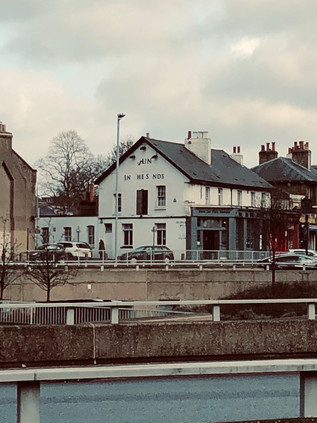
It was hard not to be charmed by the passage across Blackheath. The cold, bright afternoon was perfect weather for walking here, and the clouds which were shifting gradually southwards made for a dramatic backdrop. To the north, the land fell steeply away towards Greenwich and the Thames, with the classical facade of The Rangers House incongruously facing down the distant silhouettes of the Vanbrugh Estate. The house was built around 1723 for Vice-Admiral Francis Hosier during his remarkably youthful ascent through the ranks of the Royal Navy. In 1816, the house was first used as the home of the Ranger of Greenwich Park, its first inhabitant thus being Army reformer and imperial campaigner Sir Garnet Wolseley, the model for the 'modern Major-General' immortalised by Gilbert and Sullivan. From beyond the river, the caps of the shimmering silver towers on the Isle of Dogs radiated light back towards me. The road narrowed and twisted along older lines still, descending Blackheath Hill into the valley of the River Ravensbourne. I plodded on down the hill, heading towards the Thames - a relatively nearby prospect now, and in truth despite my land-bound route into London, it had never been far away. There was evidence of decay here in the windowless holes above closed shops and ageing signs offering the once-revolutionary 'Internet Access' - but there was rebirth too. Near the point where the snaking elevation of the DLR twisted around the sluggish convulsions of Deptford Creek, new towers were rising from the flat bottom of the alluvial valley with the obligatory empty retail unit at ground-level to create the all-important 'mixed-use' planning designation. There was a sense of the maritime here too though, a rougher and saltier edge to the estuarial accents yelling religious messages across the pavement in Deptford High Street. So much had changed, but so much hadn't for centuries. Just streets away Christopher Marlowe had met his end for 'the utterance of divers malicious words' - and with the resurgent tide of knife crime now dogging the city, perhaps London was again reverting to type? Deptford felt like a haven of normality though: closed pubs promised reopening, and old buildings found new purposes. The tall Victorian blocks which clustered along the A2 were faded and soot-marked, but they felt like a suburb of London should. The temptation to linger was strong, but the road had a way to go before it ended... At least I thought so - because yet again I realised I didn't really know where it ended. I flicked up the map on my screen, tracing the green line in from Kent, through Greenwich to Deptford, and then to where? The numbers disappeared in the tangle of Central London, the destination more important than the detail. I struck out along the long, shallow curve between New Cross and New Cross Gate - a vague sense of familiarity from a brief and anxious trot between railway stations once before, and recognition of a vast Sainsburys megastore where I'd bought one of the last few Mother's Day cards I'd ever send. The area felt vibrant and busy now, largely due to the presence of Goldsmith's in a string of buildings along the southern side of the road. In truth, was perhaps the A2's last desperate grasp for relevance. Beyond New Cross, the road managed to skirt the settlements which grew along the artery into London: Peckham lay entirely to the south, beyond the queasily cantilevered overhang of its modern library, Walworth straddled the road to Camberwell at the other extremity of Burgess Park. The roads in the south defied logic - those which would seem most important or deluged with traffic playing second fiddle to a tissue of capillary routes fanning between them. The traffic here ran between the suburbs rather than along the spokes of the city. The Old Kent Road was a drab, transient strip-mall of the kind frequently found in the United States. Little bursts of commercial activity stalled quickly, once busy shopfronts turned into evangelical missions and churches. The retail hangars arrived early in this quarter, empty lots being snapped up by B&Q, Homebase and Staples in early red-brick incarnations dating from the 1980s and 1990s. Drive-through takeaways now symbiotically populated their carparks. On the pavement, a string of Southwark Council funded advertising totems implored passers-by to sign the petition to get the Bakerloo Line extended along the Old Kent Road on route to Lewisham. There were, of course, counter proposals to ensure it came nowhere near the cursed tarmac of the A2. I walked a marginal zone, between the ambitiously devout Holy Ghost Zone and the scrapyards, alongside the vast flank of warehouse-sized DIY stores to the string of backstreet newsagents which inexplicably found themselves fronting the major route. It was unedifying walking: an ill wind blew along the road, almost taking my cap back to Kent. I switched it for heavier woolen headgear, not yet ready to let the chill of February into my skull. My feet dragged - and I was unsure if it was the long walk in from Crayford or the resistant drag of the gloomy route? This road had almost killed film-maker Andrew Kötting, his lost days and recovery from a motorcycle accident near here providing the unifying narrative of Iain Sinclair's London Overground.
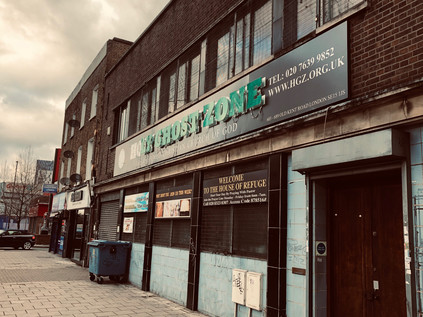
And then, the road finally gave up... At Bricklayers Arms, the carriageway parted and a concrete ramp slung traffic high above the surrounding terraces and the patch of green in the middle of the gyratory. The dominant flow was south-west to south-east, avoiding the city entirely at least from this awkward angle. Vehicles sprinted towards Brixton and Elephant & Castle, leaving the road into the City oddly quiet. I circled the junction, heading for the A2 exit which was now barely signposted and swiftly dwindled to a two-lane avenue between trees, quiet and flanked by London County Council era public housing and more recent student accommodation. For the first time in miles, perhaps even in the months since the last walk of the summer, I could hear birdsong above. The afternoon glow of the golden hour was descending on South London and the brief wintry blast of the last few days appeared to have been entirely dispelled save for a biting wind from the river. The A2 here was a spent force, only good for pilgrims making the last drag of bloodied feet towards the gabled inns of The Borough. I made my own last drag towards the crossroads where St. George The Martyr surveyed the junction of the A2 and the A3. At the moment of contact, where my route finally ended, the bells struck three - a mocking rejoinder, and a reminder that this project was barely even begun. The road in from the South West seemed long and impossible, longer even than today's slog from the icy wastes of Crayford into the gloomy, cramped terraces of Southwark. Here, perhaps more than anywhere along this ancient route in from Dover and Canterbury it was possible to picture highwaymen rubbing shoulders with penitents and pilgrims. Perhaps it was the shuffling tourists seeking the wineries and street food vendors of the market, or the heads-down weekend commuters dragging their tired feet towards London Bridge station? In the shadow of The Shard, always more impressive from a distance than beside its awkward, glassy bulk, I turned away from the A2 and faced the City at last.
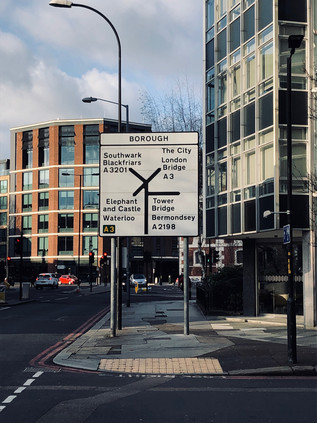
My last few yards were challenging but rewarding: though my feet begged for a pause, I couldn't recall ever crossing Southwark Bridge before. The quiet route over the river was surprisingly narrow and almost entirely free of pedestrian traffic. It has always been the quietest of all the crossings, based on a flawed endeavour it was opened as a public toll bridge in 1819 when the neighbouring London and Blackfriars Bridges were already free of charge. By 1864 the owning company was bankrupt and the crossing transferred to Bridge House Estates and made toll-free. A century after the original opening, the current bridge was built - but the habits of Londoners change slowly and the bridge remains a backwater, often used for filming or as a diversionary route. The Thames gleamed in the last gasp of low sunlight, reflecting the clear, blue skies which had churned with snow and sleet just hours before. I touched down on the north bank, feeling my range anxiety dissipate almost immediately as I zig-zagged along familiar routes to Dowgate Hill and up the Walbrook's shadow-estuary towards Cannon Street station. This walk in from Kent had seemed impossible at times: a long, frozen canyon from the south and east which appeared to have no secrets to give up. However, it had been a surprisingly engaging journey. An unwinding of the onion-layers of London via a precise incision, and a salutary reminder that plans and schemes to permeate the city by new routes rarely ever worked - however hard the planners planned and the builders constructed, the pilgrims would always progress by the oldest of ways into London, patterns unchanged for millennia. Even though it was just their ghosts and I walking the last few yards of the road towards the river, the proud past of the Great Dover Road was undimmed by it's current infirmity. There was a sense that glory lay at the end of the street - whether in the old stones of Canterbury or across the water in a swiftly receding Europe.
A gallery of images from the walk is here.
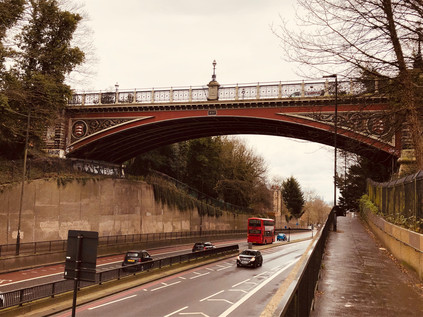
London Ordinal: The A1 - Walking into the Light
Posted in London on Saturday 12th January 2019 at 11:01pm
A month ago I didn't expect to be here in London. Arriving at the bustle of Paddington station on one of GWR's flagship new trains for the first time, I was a little early. The skies over Berkshire had seen a reassuring red dawn fade into a marine silver sheet which didn't bode well, but otherwise, things had gone to plan so far. I wasn't used to this - it had been a month of confounding twists, difficult turns and unwelcome disappointments. The turn of the year had seen our annual trip - always a highlight, and despite being a little shorter and more austere this time around, a welcome break from the routine. A plunge back into a fractious and grumpy working environment where the low rumble of national politics invaded every decision had made for a difficult week too. Delay was everywhere, inaction was the standard response. I was itching to get walking again. I didn't linger at Paddington, heading directly for the Circle Line and hence to Kings Cross St. Pancras. I was there only long enough to charge my coffee cup, grab a swift but unusually fancy breakfast, and head down onto the Thameslink platforms with BTP officers slaloming around me to apprehend some early fare-dodgers who'd somehow spoofed the gateline. As they dashed around the corner towards the stairs, one of them carefully discarded his takeaway espresso cup to better make pursuit. It was good to be back in London: outwardly civilised but always on the brink of something. As my train snaked into the station and we escaped from the tunnels somewhere north of Thomas Hardy's graveyard packed with human jam, a grey morning opened before me. A new year and a new project. Time to get moving, again, at last.
My journey out of London was the usual experience: as the interval between the suburban stations began to lengthen, more greenery crept into the window views. The sprawling city relaxed like a muscle, its margins ragged and ill-defined. I disembarked at Elstree and Borehamwood. Outside the official administrative margin, but still inside the concrete circlet of the M25 - at least, just inside... I didn't know this part of the world at all well. It was a map-smudge between Barnet and Edgware which remained unexplored, and despite being formally and spiritually in Hertfordshire, it felt perhaps more like a suburban satellite than some of the towns which had arbitrarily crept into London in the 1965 redefinition of its boundaries. While Enfield and Barnet felt like small, independent market towns which had only accidentally strayed into the city's ambit, Borehamwood felt exactly like a suburban enclave should. I navigated out of the station car park with some challenge and set off along the High Street - a haphazard grouping of national chains and local traders inhabiting a dissonant mix of 1930s shopping parades and 1990s plastic-fronted retail centres. It was busy and self-contained, and in the unexpectedly temperate January morning, not a bad place to start walking. I peeled off to the south long before the strip of shopping opportunities had ended, heading into the residential hinterlands with their mix of bungalows and modern church buildings. The road leered above me, a long straight row of tail-lamps rising ahead of me into the trees. Borehamwood ended slowly, persisting along the road out of town. Cresting the hill, I saw my route creeping in from the north to converge with my current bearings. My target today had, in fact, suggested itself a long time back, but felt like the wrong walk back then. I didn't want to be that road walking guy who endlessly recounted treks along the byways of London for their own sake. There were two considerations though: firstly, I was that road guy - a consistent string of ambulations focused on routes ancient and modern proved it. Secondly, I'd probably always been thus. My earliest memories are of lying on the living room floor puzzling out an interchange or scratchily drawing Primary Route signs after Kinneir and Calvert. But after all, who cared anyway? No-one was reading. I could walk wherever I wanted, write whatever I felt and remain largely unashamed of my preoccupations. I felt a sudden flush of freedom when I was pondering my walk on the train into London this morning. I was going to begin a new year with a new plan: five long walks along the principal A roads leading into London. All of them converged on the shifty, ill-defined 'Centre' of the city. All of them crossed the boundary at an inconvenient and distant spot somewhere in the scrubby, semi-industrial edgelands. This was just my kind of walking. At Stirling Corner, after visiting the local branch of Morrisons where sleepy Saturday-morning people appeared intent on crashing and colliding into each other with an alarming lack of care, I finally found the A1 arriving fresh from its bypassing of Borehamwood. A fire engine howled around three-quarters of the roundabout, quicker than braving the traffic lights and turning directly south. Traffic momentarily stopped and pulled aside, then ebbed back into the space it had left for the emergency vehicle as if nothing of note had happened. To the left, the road was simply signposted 'The NORTH', to the right the familiarly abbreviated 'C. London' which I always seemed to be heading towards - I crossed the busy carriageways gingerly and began walking. The next sign told me it was five miles to Brent Cross and twelve to Central London, while the clouds closed in overhead to form a grey, sound-deadening mass. Cap pulled tight and head down, I set off along the narrow footway beside the litter-strewn laybys which signalled my passage out of the Home Counties and into Greater London.
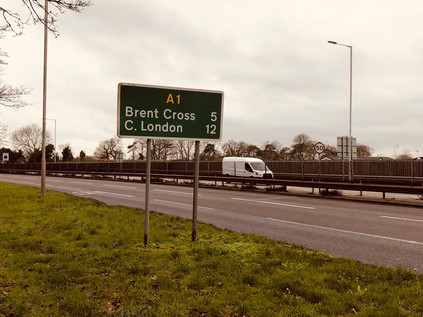
The road was broad but divided into narrow lanes which pushed the slower moving juggernauts closer to my path. I hugged the margin of bushes carefully, trying not to let my shoulder protrude in case of a stray wing-mirror. Having walked some fairly major routes around the city, this felt more precarious than any so far. The tarmac scythed through a patch of green - to the east, the public open space at Moons Moat, damp and edged by a forest of leafless, intertwined trees which presented a grim barrier against the road. To the west, a golf course - the scourge of the greenbelt - and then the M1 and London Gateway Services, formerly known as Scratchwood, after the belt of tree-covered hillside here. The services were reached by an aborted junction - a half-finished roundabout which whirled rest-area bound traffic illogically around itself before allowing them access to M&S, Starbucks and the other facilities. The M1 made a dramatic break for freedom here, curving sharply to the west and finally parting company with the railway line it had shadowed for miles out of the city. The history of the motorway and my road are inseparably linked, twin grey lines ploughing north through the lesser-valued patch of north-western suburbs which are not quite Hertfordshire, yet. Just a few days before I'd stood at the corner of Leith Street and Princes Street in Edinburgh - the start, or indeed the end of the A1 depending on your viewpoint. We'd followed its bleak and impressive beginnings south into England on our journey home, twisting into the low grey clouds which hugged the coast. It felt fitting to begin the year on this route. A band of light tinted red by the pinkish grey cloud cover broke through to the south, making the wet pavement gleam. It felt like a premature sunset. I walked towards the light...
I finally got my bearings at Apex Corner. Approaching from the south on my first visit this swirl of traffic had seemed like the end of civilisation, the A1 stretching away into the trees. Now it was a welcome return to suburbia where the road slowed and quietened somewhat, at least temporarily. I edged around the roundabout above ground rather than descending into the subways, and as a result, I witnessed the aftermath of a minor traffic incident. The police were already on scene, cars with deformed plastic fenders askance and airbags hanging flaccidly post-inflation neatly sequestered on the central reservation. I turned south, heading into the environs of Mill Hill. The land climbed to the east, into the rural edges of London which I'd skirted on the A5109 - sleepy Totteridge and the muddy slog over the fields to Whetstone lay beyond. To the west, the landscape fell away into the valley of the Dean's Brook which formed an early headstream of the Brent. The road continued south through suburban sprawl which was neither Edgware nor Mill Hill quite yet, impressive double-fronted houses and gated villas stepped up the bank, away from the road. Some of them had grand entrance stairways sweeping up to their gates, designed for impressive arrivals by equally prestigious motorcar and likely not used now that they provided access only to the litter-strewn carriageway of a shuddering, congested expressway into London. A street of shops led away west to Mill Hill Broadway station, the settlement's spiritual and commercial centre as defined by M&S Food, lying some way from the brow of the hill with its impressive views over West London. Away beyond the northbound carriageway a small knot of red brick civic buildings clustered together - the stocky, almost ecclesiastical tower of Mill Hill Fire Station glowering over the single-storey public library opposite. I continued along the route south, passing the exotic crop of domes which housed the telescopes of the UCL Observatory. Opened in 1929 the low-rise buildings were sleek, whitewashed blocks very much typical of their time, supporting the silvery domes which housed the range of telescopes, the earliest of which was manufactured in 1881 with the most recent installation just last summer. The road bisected the expansive spread of Mill Hill Park, accessed from the A1 only by a gloomy looking footpath leading to a subway linking the two segments of green space. As the road began to rise above the level of the back gardens abutting its course, I experienced the unsettling jolt of recovering a memory: I had scanned this part of the map in detail for a previous expedition. Ahead was a site of double abandonment.
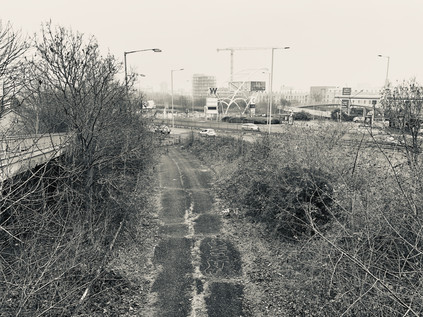
Plans to extend the Northern Line have never fared well, and the interruption posed by World War Two cancelled many of the projects in the New Works Programme which would have seen these northern suburbs better served by the underground, largely by integrating the Edgware, Highgate and London railway into the system. This railway, authorised by act of parliament in 1862, carved an ambitious and costly path into the Middlesex suburbs which were growing over the hills and valleys north of London via audacious tunnels, viaducts and embankments. It also filled a marked gap in the growing Underground map. While the former Palace Gates line is a better-known casualty of post-war austerity, now the Parkland Walk, a further scheme was also cancelled. Currently, some Northern Line trains don't make the awkward curve east towards High Barnet, continuing instead to the rather lowly single-platform terminus at Mill Hill East. Historically, High Barnet was the branch line and this, the mainline, originally reached Edgware by way of the route which passed under the A1 here. The line was near ready for conversion to Electric operation by Northern Line trains when hostilities curtailed the plan. Parts of the route still appear walkable while much has succumbed to encroaching development, but this section of the line's course survived to serve again, becoming the temporary terminus of the M1. Built piecemeal over the course of the 1970s, the route of the motorway into London was a bewilderingly challenging project, the final course of which depended on the plans for the Ringways and the complexities of squeezing a major road into the narrow channel through the hilly edges of the suburbs in which the Midland Mainline already ran. For a time while the politics and practicalities of motorways into urban London were evolving, a temporary terminus was constructed swinging traffic east to join the A1 here, just north of Fiveways Junction. Looking down on the abandoned sliproad, last officially part of the M1 in 1977 when the final section to Staples Corner opened, I was amazed to see a fairly intact road surface and mossy but extant metal crash-barriers below. In fact, the route saw a third incarnation when, following the IRA bomb at Staples Corner in 1992, it was resurfaced and pressed back into use as a terminus for the motorway once again. Maintained as a strategic priority until the early part of the 21st century, the road was now beginning to return to nature once again. A footbridge zig-zagged over the curve as it began its ascent to rejoin the A1, and at the end of the ramp I found a spot where I could scramble over a patch of wet grass to stand on the surface, exit blocked by locked barriers and huge concrete blocks, while the traffic on the A1 unsuspectingly sluiced surface-water towards me. I pondered this tiny rediscovery as I picked my way back to the footpath: my walks were often overtaken by these fragments of microhistory which, taken in isolation, seemed inconsequential. But I found a strange solace in standing on this rather heroic bit of infrastructure which had returned and returned again to serve the ever-evolving transport needs of the capital.
I negotiated the grim, clattering flyovers of Fiveways quickly but was careful to note the group of cast lions standing atop pillars around the junction. David Annand's sculptures, commissioned by the Highways Agency as a foil to the unrelenting noise and inconvenience of the frequently traffic-snarled junction, delighted in the punning title 'Civic Pride'. I ascended a bleak, narrow sliproad to join the traffic braking hard to readjust to urban conditions at the end of a higher-speed trip along the M1, my route rather suddenly changing pace too, and reverting to life as a rather quiet arterial route. Like all approaches to London, the road was flanked with large, mid-century villas which were now forlornly marooned alongside six lanes of traffic, and I trudged through a persistent drizzle along the dusty service roads which was all the separated these homes from the bursts of traffic emitted by the junction. At least the steady mizzle of precipitation kept the dust down. The road banked downhill, navigating its way into the confluence of the Dollis and Mutton Brooks below. The terrain here felt comfortably familiar - I'd previously crossed the route at Finchley Lane, and stalked the course of the Dollis Brook along the valley floor. I knew I was closing in on the North Circular near a point where the walk I'd taken there had begun to feel impossibly long and debilitating. The junction, where Great North Way folded into the North Circular as Falloden Way, was a complex entanglement of traffic signals and lane choices. Traffic approaching it fenced and jostled for position in the correct channel, space was contested and fractious. My irritability with the surroundings was rising too and I felt like I was picking up something of the road's temperament, but I resolved to stick to the tarmac and not use the path along the Mutton Brook as I had on a previous crossing of the valley. This would also allow me to get a look at the impressive frontage of the Finchley United Synagogue. Approaching the building, several things were apparent: firstly that security was very tight - yellow jackets and headsets teemed around the entrances and escorted departing worshippers to their cars. Also, the facade of the building was so impressive that I needed an angle on it. I crossed to the grassy triangle of Charter Green and turned to frame the building in my camera. The vast finned shield gleaming in the grey morning like a huge radiator, pairing with the defiantly lofty sword of La Délivrance, Guillaume's wartime sculpture purchased by Lord Rothermere and insistently sited here to enable him to see it when driving to his mother's home. The moment I clicked the button, the yellow jackets were triggered. As I turned to walk away, they shouted after me and heavy footfalls could be heard. A small group of them joined what was to be a short and low-speed pursuit as I figured that engaging was going to be the better outcome here. They caught up with me on the green and a couple passed by to ensure I was fully encircled. The leader stepped forward, a stocky but well-spoken young man bedecked with badges of authority and communications technology. "Do you know what the building is?" - I agreed I did - "So why did you take a picture of it? Can I see your camera?". I sighed - this all felt predictable and I dreaded writing of it. These challenges by extra-jurisdictional hi-vis have become all too common and are generously over-written. Anyone who dares to walk outside a set of unspoken but apparently acceptable routes will suffer such events at some point. I railed at the thought of having to describe this here, throwing myself open to derision for my hackneyed, privileged white-guy psychogeography yet again. But, however much I bristled the rule is to stay polite and firm - and I did. I first spelt out the deal - yes, they could see my camera so long as we agreed they couldn't remove it from me, handle it or attempt to delete any of the images I'd taken. Also, that despite their well-executed encirclement they had no power to hinder or detain me. A little taken aback by the well-practiced nature of the delivery I suspect, the young ringleader agreed readily - as keen to end the debacle as I. I showed them my litany of dullness: grim shots of a litter-strewn Dollis Brook, crumbling concrete stairs to nowhere, gantry signs above a rain-gleaming roadway. He looked confused but satisfied I was no risk, or at least not to the Synagogue. The yellow jackets relaxed at his relief, hands returned to pockets. They scanned the green for more pressing matters while their leader wrapped things up here. "I'm sorry sir, you'll understand why things are like this just now?". I agreed I did, and that I too was sorry that he needed to apologise for this here, now in Britain. We talked a little more - about how they'd seen protests from both the far-left and far-right, and how the temper of the debate was changing, getting edgier and more directly anti-semitic. We parted on good terms, and he returned to guard the synagogue. That last phrase is something I still find myself surprised and saddened to be writing in 2019.
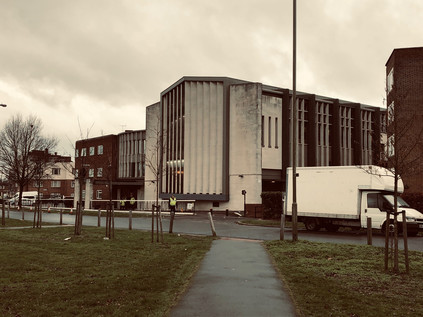
Beyond this encounter the road felt muted and strange. After forking from the North Circular and curving south and east, it also seemed quieter and somewhat less important. This peeling away of traffic as the road crosses significant routes was a feature of London's radials which I'd forgotten until now. Slowly, even the greatest roads towards the City dwindle, and the A1 appeared to have lost a good deal of its strategic heft back at Henly's Corner. Now, the road hugged the valley of the Mutton Brook which wound back and forth under it, occasionally evident beneath a tangle of greenery before it disappeared into Northway Gardens. This stretch of road dated from the First World War, and was built to serve an extension to the model cul-de-sacs of Hampstead Garden Suburb which hugged the contours of Highgate Hill. Founded by Dame Henrietta Barnett who had, with her husband Samuel, also masterminded the Whitechapel Art Gallery and Toynbee Hall, the suburb took its cue from the beginnings of the Garden City movement. The suburb was to be an egalitarian enterprise, providing dwellings for all classes of person in detached houses with gardens. There were to be hedges rather than walls, and the streets would be broad and tree-lined with a much lower density than was then common, even in the suburbs. The homes to the south of the road were fine, cottage-like and attractive - and it's no wonder that the area continued to feature a number of celebrities among its freeholders. To the north of the road, the houses were a little less elaborate and more prosaic, but the magical effect of the suburb seemed to linger over them too. I wandered into the Co-op on busy Market Place and shared my concerns about the poor quality bananas with an elderly but spirited German woman who seemed less inclined than I to let this pass unremarked to the manager. Back out on the road, I ate while I walked, mindful of the time and the challenging distance ahead. I was curious to stray south towards Sir Edwin Lutyens' Central Square with its two churches and impressive school buildings, but that was for another walk. One which might equally stray along The Bishops Avenue which crossed my route nearby. Part of a cluster of streets named for Arthur Winnington-Ingram, one-time Bishop of London and prolific local landowner, this street has become an almost ludicrous proposition: sometimes regarded as the most exclusive street in London, it winds south from East Finchley towards Hampstead Heath and is lined almost entirely by mansions. The list of owners read like an unlikely collision of mid-century British culture (Katie Boyle, Sir Billy Butlin, Gracie Fields) and flat-out crooks (Emil Savundra, Asil Nadir). Nowadays, the properties are in the hands of Sultans and Saudi royals, many of them maintained only as investments in the overboiling property market which London currently provides. They still launder money through this odd little enclave, but it's all above board nowadays. On the A1 though, no such lofty denizens were found - save perhaps for an infant Jerry Springer raised in the sweeping moderne blocks of Belvedere Court - and in fact I realised that I'd seen few people walking at all, even in this relatively pleasant suburban stretch. My route was fast closing in on the old road north - a route I'd crossed and recrossed on my earlier walks through Barnet, Whetstone and Finchley - and now I met it at a dour, choked gyratory where the terraced houses ended in an abrupt demolition plot. The rest of the terrace had long since been cleared for the new road's progress exposing, the internal geometries of the chimneys to Bakers Lane. Here I turned south again, back onto the original route of the Great North Road into London.
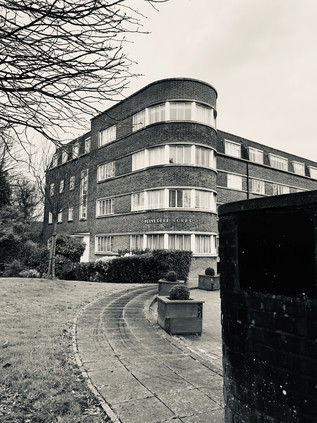
For a brief stretch the road felt familiar - I'd blundered unexpectedly into Highgate once before when navigating between the north and south sections of the Parkland Walk, and then - as now - it was a shock of bustle and pedestrian activity. I jostled with small groups of other human beings at the street crossings, narrowly avoiding properly equipped cyclists in their expensive an unforgivingly tight kit. It's fair to say that I'd hardly strayed from relatively affluent areas of North London on this route, but this felt much more ostentatious. For a while at least, the focus shifted from the grey asphalt strip which had defined the walk to the smells of tiny delis and the chatter of young people outside stores. I was glad to be able to gaze down from the path onto the roof of the decaying surface-level railway station which had once graced the Northern Heights line. Its quiet repose beside this busy street was comforting, and the temptation to plunge into the trees and enjoy the walk along the leafy chasm left by the ghost railway was very strong. Instead, I left Highgate behind, heading south along the deepening cutting of the former turnpike built to avoid the steep hill and originally proposed as a tunnel by engineer Robert Vaizie in 1808. In 1812 the tunnel workings collapsed and it was left to John Nash, the darling of Regent's Park and its Regency terraces, to rescue the project with a brick viaduct above the deep chasm which gave the area the name Archway. Replaced with an elegant cast iron bridge carrying Hornsey Lane in 1893, the crossing still defines the landscape: as the road dipped to pass through the geological outcrop of the Northern Heights, the towers of the city were framed by the flanks of the cutting with the ornate bridge above bearing the arms of Middlesex. London shimmered through the window of the bridge, cloaked in a grey mist with a rosy cloud drifting across an attempt at an early sunset. It was hard not to be awed by the idea of blasting this culvert through the side of a mighty and ancient hill. The hazy view of London in the middle distance brought to mind the legend of Dick Whittington, turning again from these heights to return to London, taking up the office of Lord Mayor three times. The area has subsequently adopted Whittington as its genius loci with a modern hospital bearing his name climbing a substantial way along Highgate Hill. The real Whittington had a more prosaic ascent, and one not so unusual to modern audiences - having never truly been a poor man, he came to the City to turn his hand to trade and then to more lucrative money lending. He gained favour by making loans to King Richard II, and was directly installed as Lord Mayor upon the death of Adam Bamme in 1397. The Crown had previously seized the lands of the City due to misgovernment, and an early act by Whittington was to regain these lands for the huge sum of £10,000. Richard II's deposition and the subsequent reigns of Henry IV and Henry V did little to affect his good standing, and he brought surprisingly modern changes to the medieval City, including facilities for unmarried mothers and a vast public convenience known as Whittington's Longhouse. On his death his generous gifts assured him a place in the memory of London, allowing the building of a library at The Guildhall, extensive rebuilding of Newgate Prison and repair of the crumbling St. Bartholomew's Hospital.
The Turnpike rejoined the old route north at the foot of Highgate Hill where a predecessor of the Whittington Hospital still broods on a corner site. The Holborn Union Infirmary opened in 1879, providing separate accommodation for Male and Female patients in an imposing yellow brick neo-gothic building with tall wings to the north and south. By 1895 the site had already been extended, a pattern which would follow throughout the twentieth century as local need grew and treatment evolved: at some point, glass verandah were added to the south-facing walls of all blocks to allow tuberculosis patients access to sunlight and fresh air. In 1944 the hospital merged with the nearby St. Mary's Hospital and Highgate Hospital to become the Archway wing of the new Whittington Hospital. It remained part of the new NHS until 1980 when functions were centralised on the current Whittington site. The building fell into decay until it was jointly purchased by UCL and the University of Middlesex in 1998 to provide a new campus for health and professional studies. Now it was again abandoned and boarded up: a Victorian imposition in the ever-modernising whirl of Archway. The forlorn, somewhat forbidding building is part future movie set, part sad hanger-on from what the locals will tell you were better times. It's harder to picture this rose-tinted past from the perspective of arrival via the A1 which was once a far less pleasant experience. Nowadays, the newly regenerated and partially gentrified Archway bustles and crackles with activity. The once dominant road network which marooned the area in the midst of a churn of impenetrable traffic has been defanged by closing a section of the gyratory. Instead, a paved market area leads through the centre of the pattern of old streets which pre-date the motor car. Outside a branch of Starbucks, a wedding party was being photographed in their finery, holding freshly brewed drinks. I must have looked askance, as an onlooker leaned over to confide "It's OK, they work there. It's where they met". I suspect I hadn't been the first disapproving passer-by in a street where pleasant, independent businesses rubbed shoulders with multinational mainstays. My last visit here had been in the early 1990s and plainly put, Archway had been a traffic-choked, grimy dump at the time. We'd played a gig at a pub more used to Country and Western acts on Junction Road, promoted by a wiry old Fields of the Nephilim fan with the unlikely moniker of 'Slim Chance'. To a country boy - Somerset via Worcestershire - the pavements had reeked of unfamiliar cuisine and the area radiated menace. It was perhaps my third trip to London, and first out of the western edges and into these cosmopolitan northern districts. Even setting aside my novice status, it was hard to see why the Archway of the late 20th century could be a nostalgic time or place for anyone who'd lived here. Not least because of the presence of the baleful gravestone of Archway Tower - a darkened tooth which seemed to overshadow their memories and anchor the zone in that era of bad politics and worse dental health.
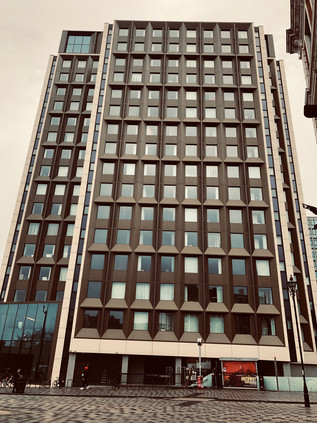
The tower was completed in 1963 by Oscar Garry and Partners, providing seventeen storeys of office accommodation for government departments, financially advantageous by being well outside the central area, but still eminently accessible by Tube with Northern Line station in the basement. By 1967, via a process of selling-off and leasing back, it provided offices for the then Department of Health and Social Security, which remained on two floors near the top of the building until 1994, a little after our awkward gig just along the Junction Road. For almost all of its existence, it has been despised by most locals and those passing artists and musicians who often decamped here from points north on their journey towards fame or infamy. The ground around the tower swirled will ill-winds, caused by pressure differentials around the stark sides of the building, and the rite of passage of attending a dehumanising interview in the building to obtain benefits seems to have been amplified in horror by the looming fabric of the tower. As buildings go, it doesn't appear an especially terrible one - but it is perhaps hard to love because of its imposition on the low-rise suburbia around it. Archway developed slowly in the 19th century as the slums of Somers Town and Camden were cleared and railways threaded into the city, and the terraces of London Brick which gradually filled the lower flanks of Highgate Hill weren't built to bear this overshadowing behemoth, clad for much of its working life in gloomy black marble. My own memory returns as I catch sight of the glowing blue of the station sign beneath the tower: walking up Junction Road into an eddy of people and traffic, dodging beggars and drunks who were haphazardly tottering away from the tower as if repelled by its magnetism. We paused at the station entrance to meet a friend of one of our party arriving from a long trip in from Sheffield. She was late, the single working escalator disgorged endless passengers, but never her. Finally, her knitted hat peeked over the emerging steps, shoulders hunched against the city, looking small and a little terrified at the prospect of Archway being slowly revealed to her as she rose. My friend threw himself onto the filthy cigarette-strewn pavement in relief at her arrival, oblivious to the ominous dark stains creeping from the walls. Above us, with no light left to reflect from it, the building disappeared entirely into the darkening night sky. It appeared to me rather like the object on the cover of Led Zeppelin's 'Presence' - an ill-defined and inert but obviously sinister absence of a thing.
The tower lay empty for some years while rumours of demolition and gentrification competed for column inches in the local press. No-one agreed on the right course of action - and everything was unfunded and impossibly hard to accomplish while Archway was essentially a huge island in the strategic road network. The local eyesore was, however, a rallying point for the discussion about what Archway could become. In 2012 an art installation by Ruth Ewan used technology to present a live view of the Island site without the tower. It was memorialised in a booklet of reminiscences called How to Make Archway Tower Disappear which included the stories of workers from the DSS office, musicians, artists and local residents. Among them, the comments of local MP Jeremy Corbyn stand out: for him, the tower was a deliberate brutality wrought on the poor - both those employed by the state and the unemployed who plead their cases to them. He fuses form with function, seeing the Tower's rather unremarkable 1960s vernacular as an assault on an older London. A pre-welfare state London which was surely less fair and more precarious to live in perhaps? The non-committal nature of his localism stretches into the current political unravelling, and the question remains where are any of us, actually from? There's no plan in all this - just an appeal to an impossible, distant past on all sides. Apparently the most remarkable aspect of the tower was the view across London in every direction from the upper floors:
There are some nice parts of London You can see them from hereThe site was finally redeveloped and rebranded as Vantage Point in 2016 and today is clad in neutral tones, fading into the winter skies and only reflecting a little light back from carefully tinted window panes. The slab-like visage to the north and south is mute and softened by the cladding and it begs to be ignored as an unremarkable residential block. It is still, by far, the tallest building for some way around, despite competition from its contemporary 1970s neighbour, Hill House which now shimmers in mirrored glass, bouncing light onto the new pedestrian area outside the utilitarian, stocky brick Post Office. Whether it was the opposing wind channelling along the new market square or the magnetic force of the monolithic building, it was hard to escape the drag of the Tower. I briefly considered a diversion to find the site of our musical endeavours along the street, but there was too little time, and while the sky was clearing to reveal a brightness ahead, the sun was fast sinking. I wanted to reach the city in the light so I headed on towards it, passing into the edges of Holloway.Saint Etienne, 'Archway People', 1993
The Great North Road has its very origins in Holloway with a new road opened by the Bishop of London, owner of much of the land around Highgate Hill, by 1318. This safer, straighter escape from the city laid the foundations of the direct route north which survives at least as far as Archway where newer alignments take over. Much else about Holloway is unclear - and while tempting to understand its name as a rural hollow-way, worn deeply into the ground by the cattle heading for Smithfield, it is as likely to be a reference to the Hallowed Way to pilgrimage at Walsingham. In either case, modern Holloway bore little relationship to either a via sancta or an ancient cattle track. The much-improved pavements were broad and busy, carrying steady traffic from the station at Upper Holloway to the Tesco Metro and Sainsbury's Local which fronted up to the curious brick missile silo of St. Gabriel of Our Lady of Sorrows. The area fizzed with energy largely due to the presence of residential accommodation for students which is strung between the Archway Campus of Central St. Martins and the dour, overhanging concrete tower of London Metropolitan University. In the midst of this was Emirates Stadium, home to Arsenal and on any other Saturday, a little over 60,000 of their devout. Today, the team was across town, playing at West Ham's London Stadium in the midst of the Olympic Park. The eateries and pubs of Holloway were busy, but not overwhelmed and I longed to step in and rest in the increasingly fancy looking premises as I headed south and deeper into Inner London. I crossed a rubicon at Nag's Head - I'd passed through before, both on an excursion along the A503 to distant Wanstead and when I was heading back from an attempt on the North Circular. As such it felt like a boundary to a known London. A string of local businesses and familiar bookmarkers signs clustered alongside pound shops and takeaways, hugging the crossroads. It felt almost comfortingly typical - like I was home in a semi-suburban London I knew better. Beyond here, though I'd not walked much of the remaining route, I knew I was within the range of buses and trains which would get me back to somewhere near where I needed to be. My range anxiety melted away, and it became clear that it was perhaps the presence of slight frisson, a mild fear of the unknown which had kept my feet moving thus far. I felt heavy and tired, the remaining distance weighing on me as the road dwindled into a less important link between the City and the suburbs. It felt like the A1 was giving up on me, rather than the reverse. At Highbury Corner I felt myself pass through another shockwave of the nearing city - the station pulsed with activity, the population diversifying and the volume increasing. This felt like the London I'd known from my earliest visits. The darkness of Archway couldn't penetrate this far, the Tower was gone from my view now.
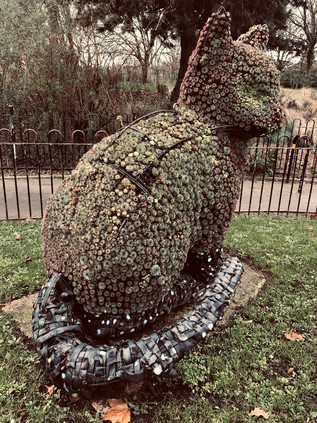
The pace accelerated, the city drew me in. Soon I was on Upper Street, with memories of snatched meals and happy reconvening after days spent walking. On Islington Green, Sir Hugh Myddleton stood guard, the remnants of his New River trickling underground now, streets away. Traffic careered around the junction and I realised what a destination in its own right this little corner had become. Shoppers filled the pavements, spilling into the road and precipitating attacks of honking as they blundered back onto the kerb. Despite the usually glum retail prospects for January, there were plenty of store-branded bags in evidence. Islington was fully gentrified, at odds with its radical associations and celebrated position as a centre of political influence. The seagulls, in particular, benefited hugely from the footfall, pecking at discarded scraps and strutting along the edge of the raised pavement. Since the 1960s the area has been dragging itself slowly up - terraces rejuvenated by middle-class owner-occupiers, cracked panes exchanged for CND stickers and wind-chimes on the porch. The district is home to a very specifically London kind of left-wing thought: intellectual rather than spiritual, honed in academia, hard to pin down and utterly dependent on the success of capitalism for its continued existence. This is where people voted to remain in the EU and can't for the life of them see why anyone wouldn't. This is where injustice is felt acutely and argued against loudly, but is often genuinely experienced just streets away with stoic silence. But, a kind of centrism which appals the true believers on both wings has its shameful heart on the sleeve of Islington. It's no surprise that the Blairs settled here on their journey to Downing Street. The people of Islington can win - or lose - elections for parties. These people hold the precarious balance of the Europe question, the next General Election, and probably the Bake Off final in their digits. In Britain, you always have to win the middle or lose the game. Jeremy Corbyn is duty bound to relentlessly play up his ascetic 'Good Life' credentials to continue living in the heart of the increasingly well-off, gentrifying Borough. There was, however, little sign of anti-capitalism today as Upper Street vibrated to the chirp of chip-and-pin transactions and steamed in the fragrance of chain restaurants. I pressed on, passing the Angel and crossing City Road. I was in very familiar territory now - inside the loop of the 205 bus route - but there were surprises still to be found. I'd never walked along the northern part Goswell Road - always preferring Bunhill Row or Whitecross Street to enter the City from the north with a nod to either George Gissing or William Blake. Suddenly, rearing above me like a chequerboard slab was Turnpike House. The entrance was via an elegant bow-like arch at the foot of the block, with tantalising hints of green space beyond. For the second time on this walk I thought of Saint Etienne. My appreciation of their work had begun early, with a crop of vital, life-affirmingly retrospective pop anthems which emerged in the 1990s. But we drifted apart: I found my niche in noisy low-fidelity art rock, and they strayed alarmingly into club territory. Worlds would occasionally collide in the following years with a snatched hearing of a new single or an appreciative glance at the ever glamorous Sarah Cracknell on TV, but I imagined that my London of grimy concrete and semi-industrial suburbs would never again align with their West End swagger and black-and-white movie chic. Then, almost a decade after I'd first heard them, a new side of Saint Etienne began to emerge: lyrics which read like Louis Macneice poems full of North Circular kitchen-sink drama, odes to suburbia, even a brace of films about London. The first of these Finisterre arrived in 2002, directed by Paul Kelly and scored by the band with a gritty, sometimes rather angular sounding electronic pulse. It was a hymn to the London of the early 21st century, but it drew unashamedly on the documentary films of the past, nodding knowingly at The London Nobody Knows along with the work of Patrick Keiller. The second film, What Have You Done Today, Mervyn Day? toured the site of the future Olympicopolis on those two fateful days in 2005: the announcement of the 2012 games coming to town, and the terrorist attacks on 7th July. Between these two anchors, Tales From Turnpike House was released. A gleefully London-themed pop opera of an album with a cast of almost depressingly real characters languishing, living and loving in an alienating, modern city. Bob Stanley and Pete Wiggs, unashamed Londonphiles and historians of the urban speculated that their Turnpike House would be somewhere in Croydon, on the fringe of London - but the clues were there: the architecture and alignment of the building was perfect, and The Birdman of EC1 lived in just the right postcode district.
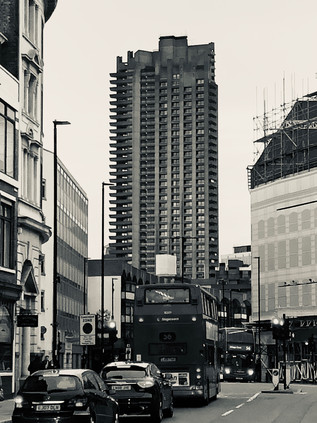
I paused for a while here, enjoying the modern sweep of the arch under the building - a shallow portal into the greenery beyond while the grid of flats began to light up in a cryptic coded pattern as residents arrived home. The block marked the edge of the City of London, an alternative portal to replace the former Aldersgate which would have given entrance to The Barbican. Now the three concrete towers of the Chamberlain Powell and Bon designed complex: Cromwell, Lauderdale and Shakespeare, aligned across my route in silhouette against the pale red of the sunset. Their jagged shadows adumbrated on the light I'd been walking towards all day. Aldersgate, spanning the Great North Road, was recorded as early as 1395 when the Lord Mayor's sword-bearer was gifted the mansion above the gate. It was rebuilt in 1617 and repaired after the Great Fire before finally being demolished in 1761. Now the ancient way was flanked by modern, anodyne commercial facades which were dark and quiet on a weekend afternoon. It wasn't always this way, and the street has more than a hint of the supernatural about it: here the Bishops of London were housed to shorten their journey from Fulham Palace to St. Paul's Cathedral, and in 1738 John Wesley underwent his profound religious experience and conversion to Methodism as recorded in The Aldersgate Flame, a sculpture sited nearby. Naturally, not all such experiences were what they seemed and in 1554 Elizabeth Crofts, a serving girl, was hidden in the wall of a house on Aldersgate Street, her disembodied 'heavenly voice' giving dire warnings about the consequences of the marriage of Catholic Queen Mary I to Prince Phillip of Spain. A crowd of around 17,000 attended over the following day to listen before the wall was demolished and Crofts discovered as its source. This final stretch - along the former Pickax Street - was hard on the feet, but was a strangely uplifting walk: a trip I hadn't dared to think would take place had led me along a route which had been unexpectedly compelling. I trudged through the low-rise blocks of the Golden Lane Estate, and circumnavigated the brick rotunda of The Museum of London which posed as a non-descript traffic island, from some angles at least. The dome of St. Pauls was looming between the crystalline reflections of the Barbican in the fascia of Cheapside offices which hid the little church of St. Vedast. The tourists lingered, aiming for a final shot of Paul's Cross in the golden hour, the sky a fine orange band behind the stark white ashlar of the building. I didn't really know where the A1 ended - or indeed began - but it couldn't go any further than the end of New Change where it met Cannon Street. I turned the corner to mark and ending at the point where I'd contemplated the possible loss of these walks back in December, in front of the Phoenix on the south door.
After lingering in the Cathedral precincts for a while, watching tourists wrapped up in winter gear framing their perfect selfies against an unforgivingly blank sky, I summoned the effort to trudge a little further, to Ludgate Circus and a familiar old coffee stop. Resting my feet there in the quiet, surrounded by students flicking at 'phone screens and staff gossiping about other crew-members, I reflected on today's walk - and on the optimistic chance that I'd be able to continue these walks despite my concerns at the end of the year. There was much to consider - new twists in my own tale to work into the coming months - but having broken ground on a new project, one which would see walking challenging miles in sometimes inhospitably non-pedestrian zones felt good. As ever, I agonised over the rules I'd impose on myself: I'd walked the 'modern' route of the A1 after all, not the ancient Great North Road - had I already invalidated my own plans? Or perhaps that walk, through the ancient villages of Middlesex, was a different walk again. At least, for now, it felt good to be contemplating the continuation of these trips.
A gallery of images from the walk is here.
Walking the suburban margins of London I have stumbled - sometimes with surprise - across a range of housing estates. The explosion in population in the outer reaches of the capital travelled through the 20th century like a shockwave. Propelled by changing economic conditions, the aftermath of two long and bruising wars and the recognition that the conditions of life many faced were appaling, these new enclaves grew swiftly in every corner of the metropolis. The schemes varied in size, in style and in ambition - from the modest in-fill blocks of 1930s balcony flats to the vast sweep of Becontree - but had one thing in common: a recognition by the agents of the state that only intervention in the housing conditions of a mass of Londoners could assure they were adequately met. On paper at least, John Boughton's tale of council housing - a term he very deliberately sticks to throughout the work - shouldn't be an exciting read. However, the progress through a turbulent century where municipalism meets modernism is compelling from the early philanthropic green shoots right up to the present where ideology finally appears to triumph.
Born out of a painstakingly well-researched blog, Municipal Dreams makes the leap from screen to page effortlessly: Boughton sifts detail effortlessly, weaving the stories of some of the key people driving the rise of council housing into the broader narrative of policy directions and architectural bravado. A range of responses to the growing need in the early part of the century is explored, from the bravely modern adopters of Corbusier's vision to those Boroughs who dabbled in the building of garden suburbs. The book is anchored in London - which was a focus of the most intense need and the most varied solutions - but doesn't exclude the work of ambitious authorities in Liverpool, Birmingham, Newcastle and beyond. Throughout, the voices of tenants are given the space they didn't get in those days before consultation was a mandatory tick-box on the decision, and the book is peppered with contemporary quotes and interviews with those who experienced the shift from slum to point block.
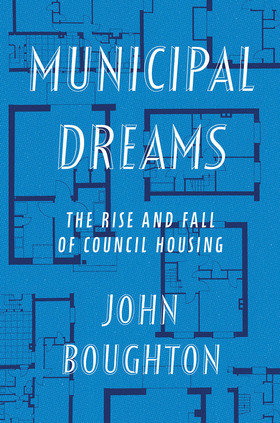
I came to this book most interested perhaps in the architectural history: and Boughton doesn't disappoint in his exploration of the rise and - tragically literal - fall of system-building, the debates about densification and the ultimate rejection of modernism. However, the book is necessarily political too - and achieves a rare balance. The simple fact, as Boughton exposes very ably, is that both left and right tackled the issue of housing via intervention and that while the positions were not widely variant at the outset, the voices of ideologues have dominated the more recent discourse. Two distinct shifts in thinking emerged as the century entered its second half: the left shifting from a broad universalism to a rhetoric of 'greatest need' while the right responded by lionizing the aspiration to escape the clutches of the state. As the new century opened and local authorities grappled with the best means to leverage capital from the private sector, these views have whirled together into a perfect storm of policy failure: there is simply not enough housing, and no agreement on how that is best remedied. Boughton's book explores both the creation and the outcomes of this dilemma with care and precision - no party is let off the hook, as the dizzying and contradictory tumble of Housing Acts endlessly rebadges but fails to increase existing investment, indulges in ill-advised tinkering and ultimately presents the same old tricks in new clothes. Council housing becomes contested, blamed, a diagnosis rather than a symptom as a result. Residualisation both creates the myth of the 'sink estate' and condemns some troubled places needing assistance to perhaps even deep opprobrium.
Council housing is a political issue - and if you approach this book from an extreme in either direction - as a radical Corbyn supporter seeking an endorsement of the state as guardian of the people, or as a steamrollering free-marketeer who wants the dubiously proven laws of economics to take the decisions out of our hands - you will be disappointed. Boughton's book is a plea to the kind of municipal collaboration and effort which dominated the discourse back when those who governed Britain shared a collective will to solve problems and when politicians could disagree across the house - and indeed along their own benches - without resorting to character assassination. The post-war consensus which endured for many decades is after all, still active in the minds of the majority of voters, and perhaps it is only in those radical fringe voices - often thought the very loudest - that we have moved so far from this. It is a strange world where 'centrist' with is an insult. Boughton concludes that the state is good at some things and not at others and that the challenge is to restore the role of council housing: something that is simply one of those good things with a host of proven benefits and demonstrable value. The book opens and closes with a vision of Grenfell Tower smoldering and glowering over the rooftops of West London. At the outset, it appears a totem of failure, but by the end, it stands as a symbol of hope: good can be done, if we can separate lofty ideology and basic needs.
Throughout this journey - which is often frustrating and sad - Boughton manages to tell the complex, nuanced story with style and balance. It's easy to take sides - to believe that one path was more morally correct than another - but the public servants Boughton describes are usually, at least, doing their utmost with what they have and making decisions based on their best ideas. That they fell short is an inevitable conclusion to this concise but engaging history of an often glossed-over topic. John Boughton's book will likely become a standard text for those trying to understand this curious and torrid period as Britain accelerated to modernity, and then came to an abrupt halt.
Lost::MikeGTN
I've had a home on the web for more years than I care to remember, and a few kind souls persuade me it's worth persisting with keeping it updated. This current incarnation of the site is centred around the blog posts which began back in 1999 as 'the daylog' and continued through my travels and tribulations during the following years.
I don't get out and about nearly as much these days, but I do try to record significant events and trips for posterity. You may also have arrived here by following the trail to my former music blog Songs Heard On Fast Trains. That content is preserved here too.
